South America Cruise, March 2015 - Celebrity Infinity

Diverse, balanced, rewarding
This is how I would summarize our South America cruise in a few words. Obviously, “fantastic, great, wonderful” would be just as appropriate, but the terms above, to me, best describe this journey in many aspects.
The cruise was diverse in every way. From a scenic point of view, we saw and experienced everything from a big metropolis to rough seas and vast landscapes. The temperatures played the full range of the thermometer and took us from 28C (86F) in Buenos Aires to 6C (42F) at Cape Horn and back to 26C (82F) in Valparaiso. And, last but not least, we met many different people on board, who contributed to making this trip another wonderful experience.
And yet, or rather because of it, I found this cruise very balanced. The different landscapes, the different types of fellow travelers, the number of sea and port days and the way they were evenly distributed throughout the trip... all this made those 2 weeks a very balanced journey. Nothing predominated, nothing made it one-sided. Everything was simply right.
After some of our trips to different corners of the world had taken us north towards Norway and Alaska, I felt grateful that this time we had the opportunity to discover the southern part of the globe and even go all the way to „The End of the World“.
Another contributor to this feeling was the overall friendly service and the offers aboard the Celebrity Infinity. From a design point of view, my personal favorite is still the Solstice Class, but the incredibly friendly crew and the impeccable service in all areas of the ship didn’t leave room for even the slightest thought of comparison. Helpful souls in the stateroom, the restaurants and the bars allowed us to simply enjoy our vacation… And, like on previous cruises, at the end of the trip we felt like leaving new friends behind.
Maybe with this report I can convey some of our impressions and take you with me to South America and aboard the Celebrity Infinity. It is only meant as an appetizer, but maybe it entices you to go and experience the excitement of this journey yourself.
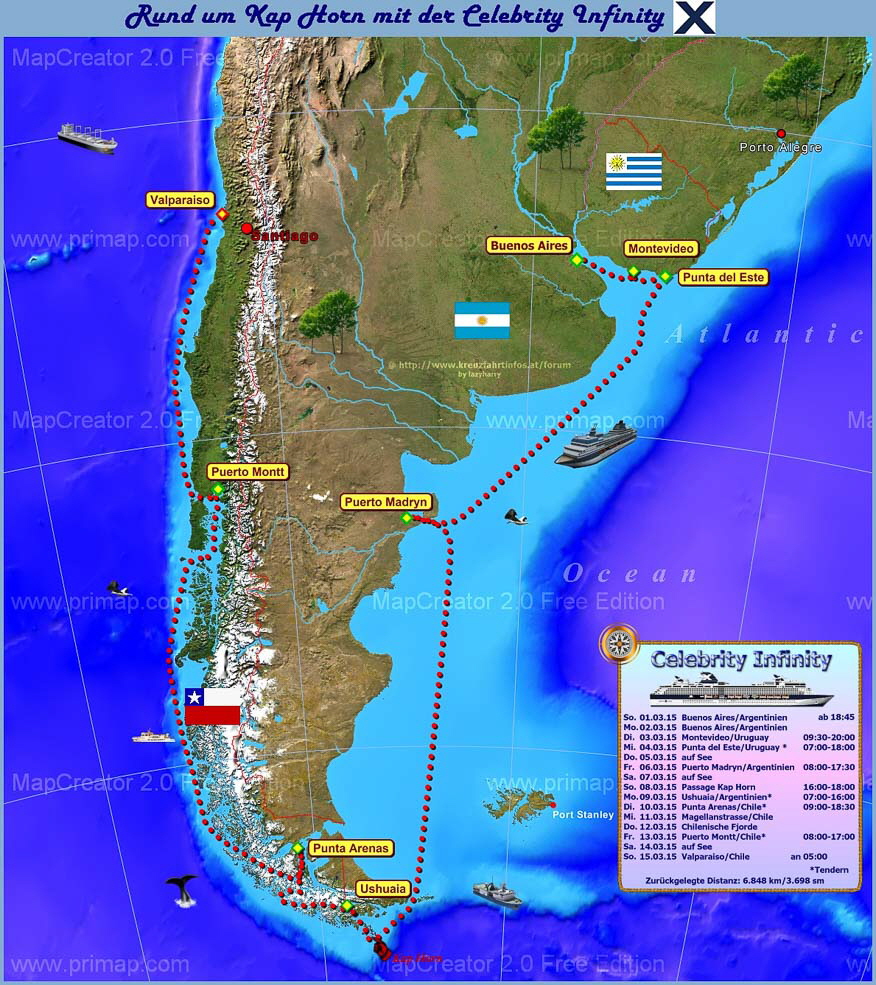
Arrival
After months of pleasant anticipation and planning, we were finally there: on February 27th, a Lufthansa Boeing 747-8 was ready to take us to Buenos Aires. We tend to think of us as lucky travelers, which we found confirmed when our departure date fell just in between two of many strikes which marked the mood of our big transportation companies at the time and didn’t seem to end.
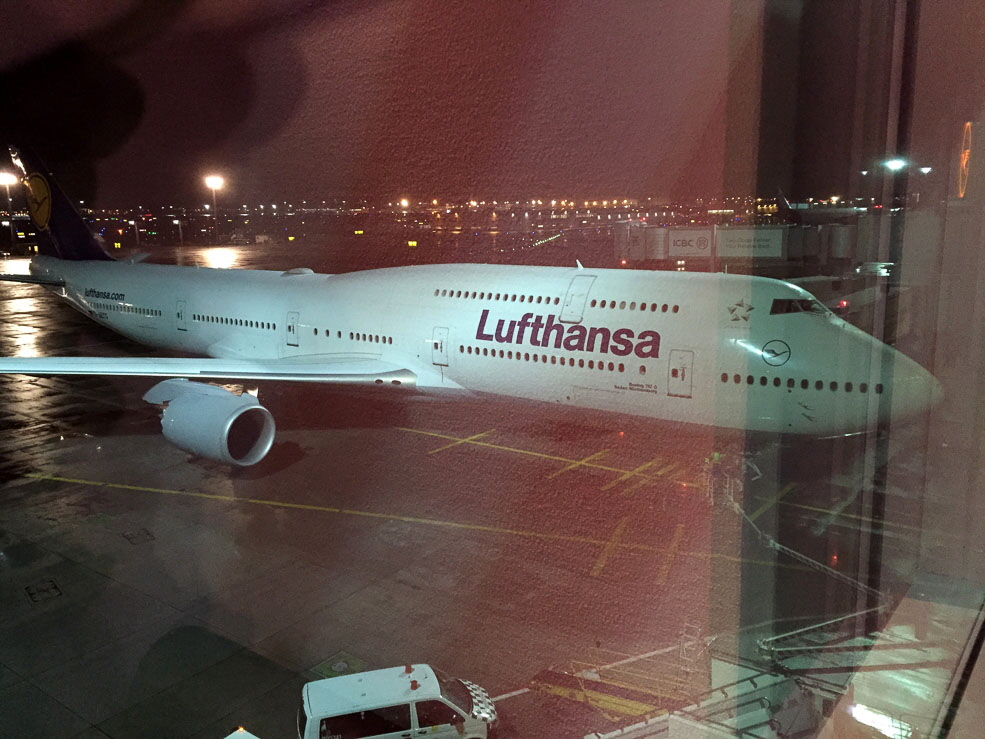
The flight only left at 10.00 pm, so we could leisurely leave after work and still had plenty of time to spend at the airport. Thanks to a Lufthansa special (and with a 14-hour non-stop flight ahead of us) we had booked the new LH Premium Economy class. It turned out to pay off twice, as for €25.00/person we could also buy access to the LH Business Lounge - even as mere Premium Economy flyers. With free Wifi, cozy armchairs, snacks and drinks, the time until boarding went by quickly and comfortably.
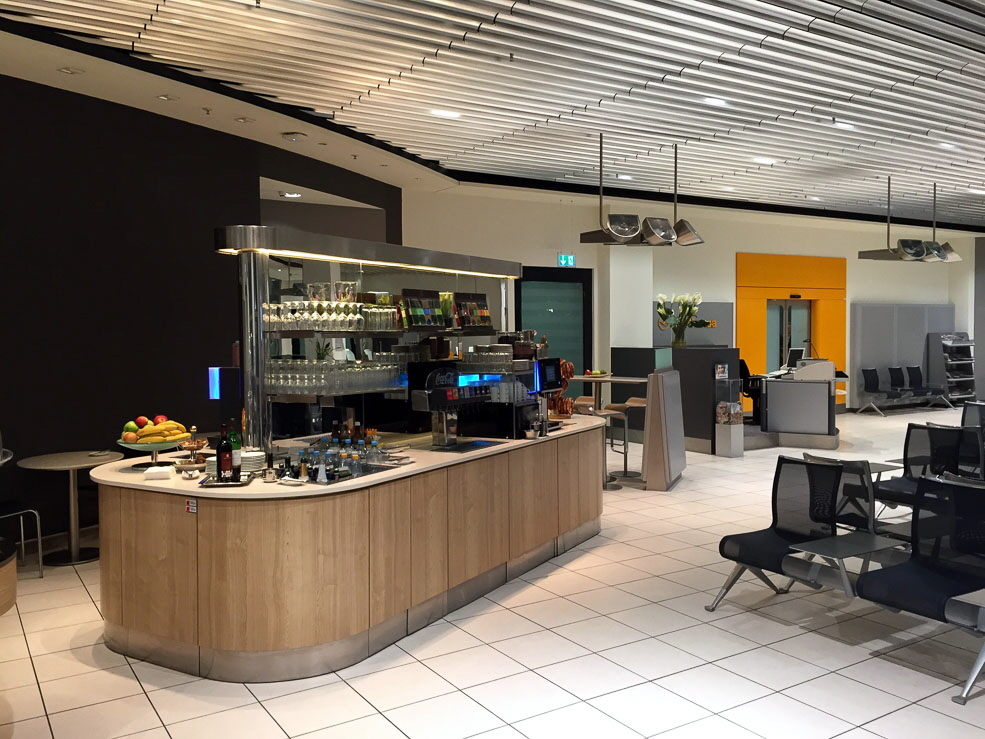
Thanks to the slightly larger seats and the wider seat spacing in Premium Economy, the 14 hours on the plane were bearable. After dinner and a film from the vast entertainment offer we drifted off to the realm of dreams and looked forward to waking up on the other side of the globe the next morning.
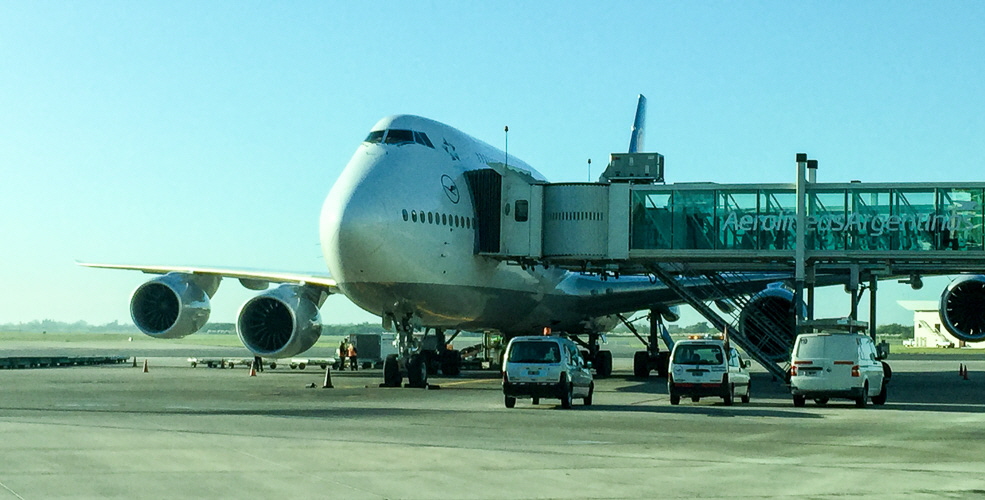
In Buenos Aires it took a while to get through passport control. The queues reminded us of bad days at immigration when travelling to the US. Actually, the glass booths of the officials looked a bit similar and they also took our fingerprints and our photos. Only their questions we less detailed.
Once we had retrieved our luggage, we soon found the blue and white “Taxi Ezeisa” desk, where you can book a “remise” to town. You pay a fixed amount at the desk upfront (some US$ 50.00), a member of staff takes you to one of the white taxis, and from there your driver takes you to your hotel safely and without any further price discussions. The fee is just slightly higher than the cost of a regular cab, and after our long flight it made for a wonderfully relaxed arrival and a comfortable transfer.
The transfer downtown took approximately 45 minutes which, in the beginning, the driver tried to fill with friendly questions and explanations. With the little Spanish we knew and much creative phantasy, we were even able to understand each other, but as he didn’t speak English and our vocabulary was soon exhausted, we continued our journey focusing on the vistas. We drove past horse stables, industrial areas and residential towers, and many new impressions rained in on us.
By 11.00 am we reached our hotel, the Sheraton Libertador – apparently together with numerous other guests, as early check-in was high in demand and only available for US$ 40.00. We had no ambition to wait until the regular check-in at 2.00 pm and accepted the offer. The receptionist even included a free breakfast for us – a friendly chat never goes amiss… But first we went to our room, which was modern and spacious.
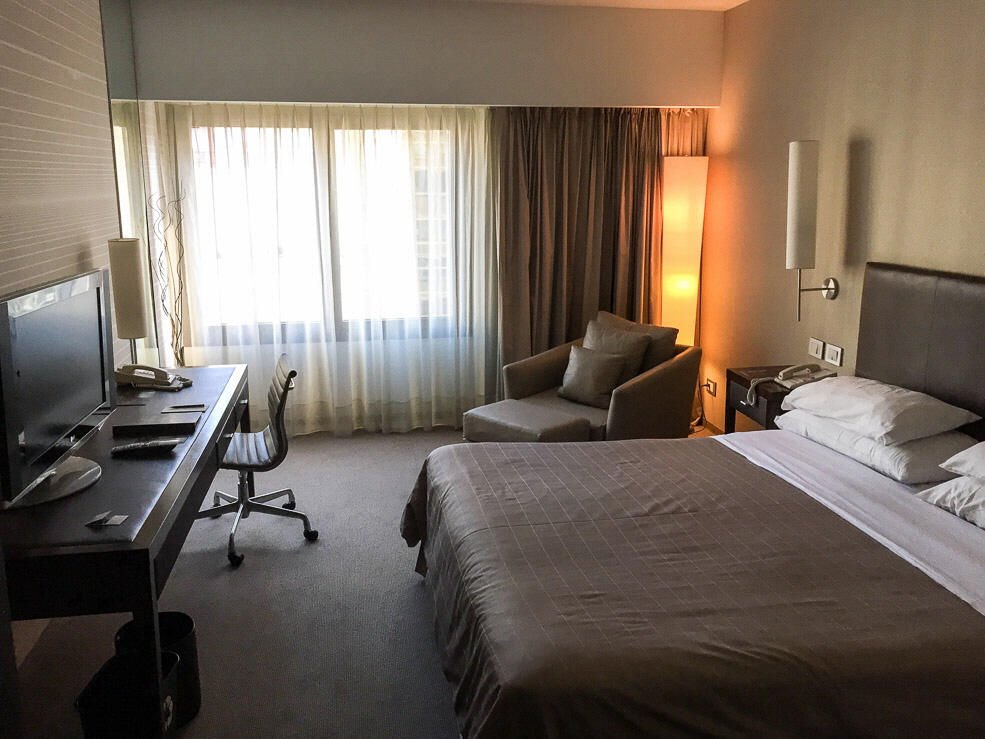
After a refreshing shower we gathered some strength at the rich breakfast buffet with fresh juices, hot coffee and national and international delicacies. The temptation to then simply fall into our big bed was enormous. The duvet promised to do its best to tuck us up nicely, but we bravely resisted. We didn’t want to let this young day go by idly ... And of course we wanted to adapt to our new time zone as quickly as possible. So we left the hotel and set off to discover this new world yet unknown to us.
The hotel was only around the corner from Calle Florida, a lively pedestrian zone with many shops and elaborately decorated buildilngs. That’s where we took a left turn and strolled along the shops.
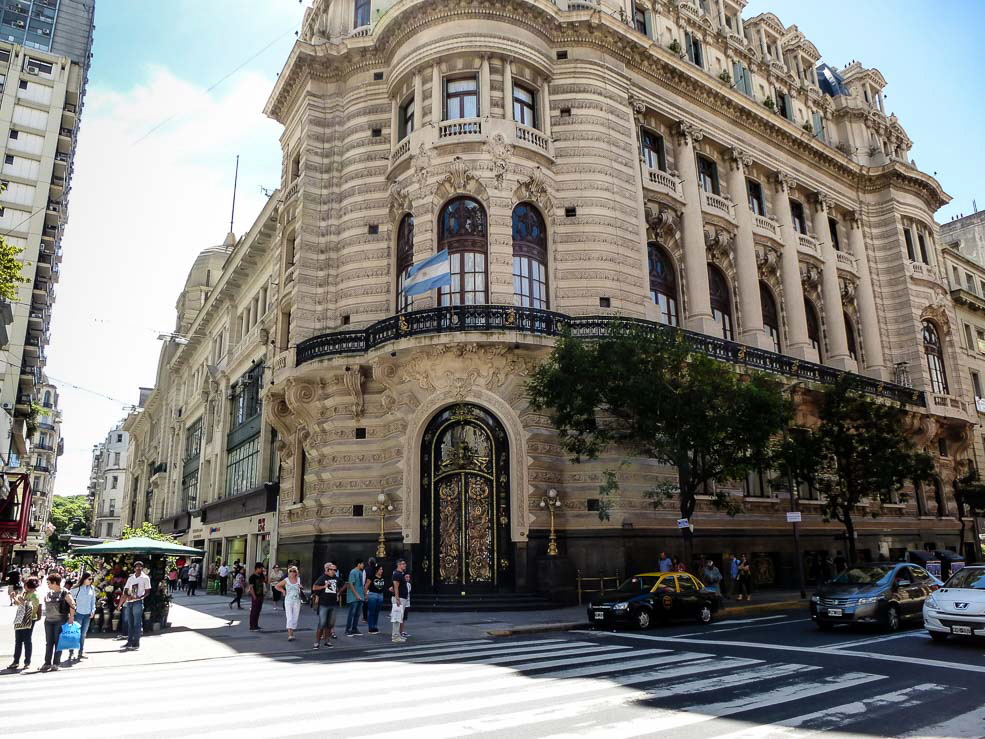
From all the shops, side streets and bookstalls we heard the calls of the money changers. Like rocks in a river bed withstanding the passing current, they stood in the stream of passing people and tried to lure them with their calls. “Cambio, Cambio, Cambio...” – droned monotonously by some, sung like a melody by others, these words were the ever-present background music on Calle Florida. Every few meters we were asked to trade Dollars or Euros for Pesos. Never unfriendly or pushy, but persistent and continuous ... like the constant dripping that’s said to wear the stone.
For visitors, this is actually the cheapest way to buy local currency. The official exchange offices, banks and cash machines (the use of which is not recommended), use the official exchange rate fixed by the state. Almost all restaurants and coffee shops also accept US dollars and Euros, also using exchange rates leaning more towards the official, less favourable rate.
The seemingly endless army of money changers uses the so-called “blue rate”, which is far better than the official rate. Like a regular exchange rate, the blue rate is continuously redefined and can also be checked on the internet. The only difference between the money changers is whether they trade at 12.40 Pesos or 12.45 Pesos per US Dollar and thereby make a few cents more or less than their neighbours. The whole process is generally unproblematic.
For the time being we had no need to change money and were, admittedly, also a bit skeptical at first. Therefore we ignored the calls and sing songs and soon reached the Plaza General San Martin.
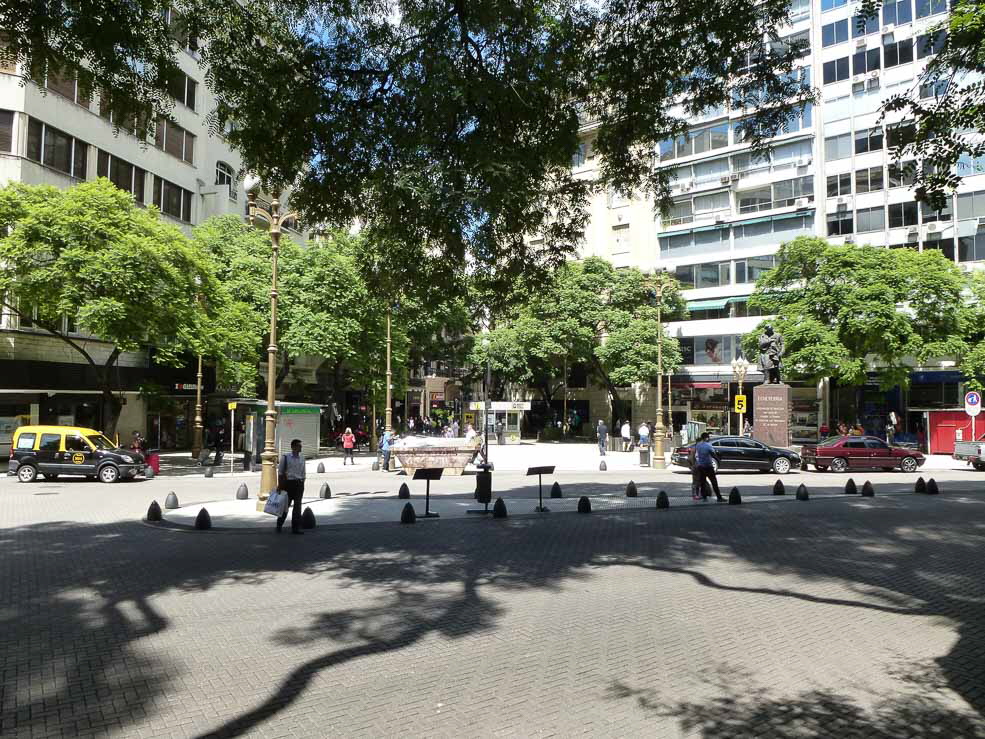
It felt like we had passed an invisible wall behind which the cambio calls of the money changers were replaced by the singing and chirping of birds. Flowering trees covered the entire square with their magnificent crowns and offered cooling, much appreciated shade. In a fenced dog playground in the middle of the park-like square, dogs and their walkers alike enjoyed a well deserved break.
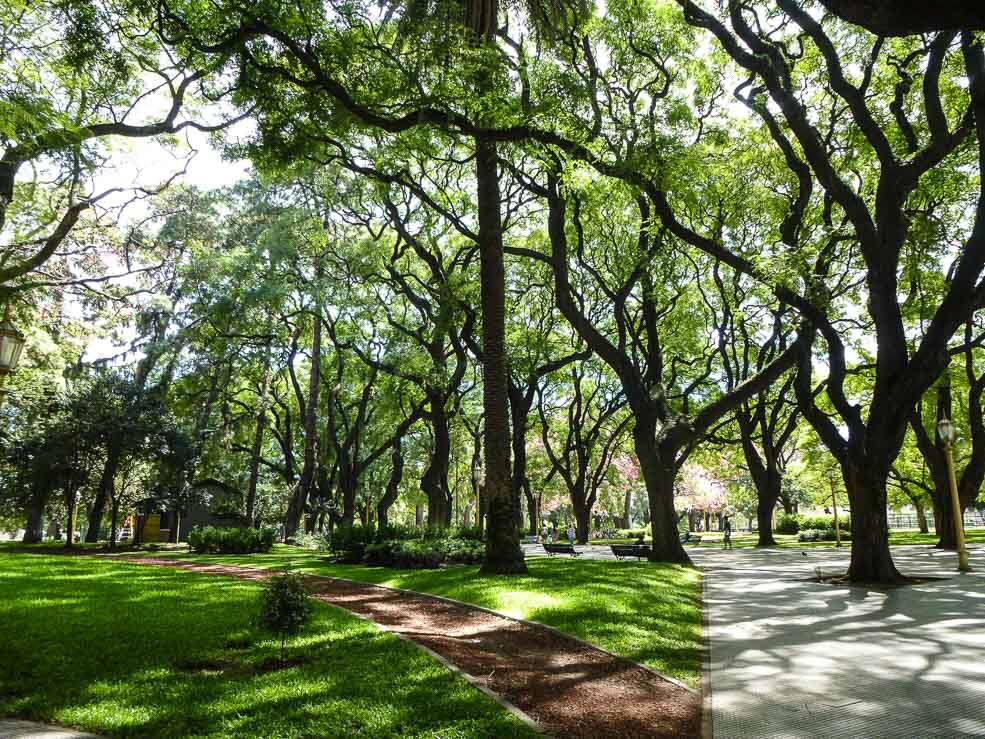
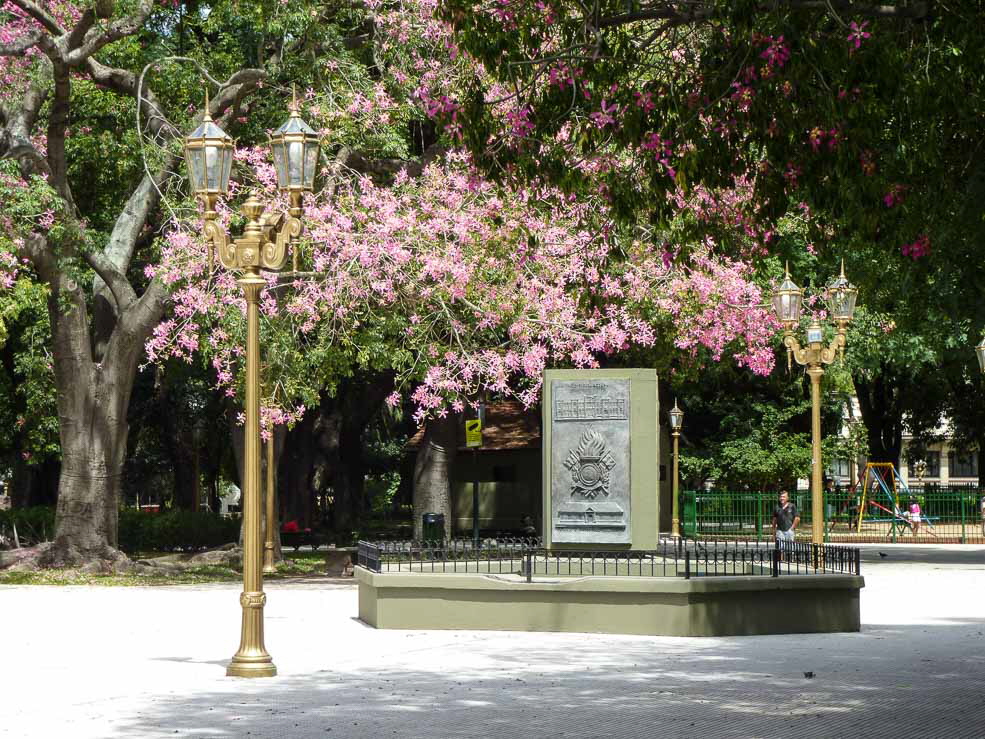
This beautiful park seemed like an oasis of peace. A place, where the racing pulse of the city suddenly slows down and where the shelter of the canopy of it´s trees offers refuge and relaxation to visitors. We loved spending some time there and enjoyed the shade, the tranquility and the fragrance of the flowering trees.
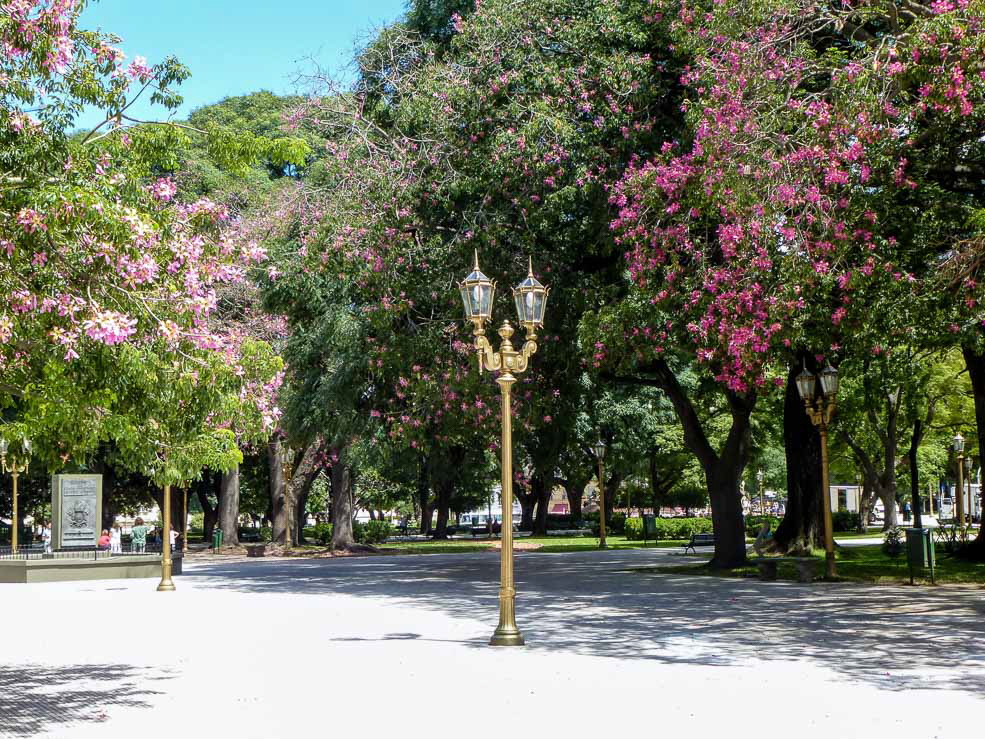
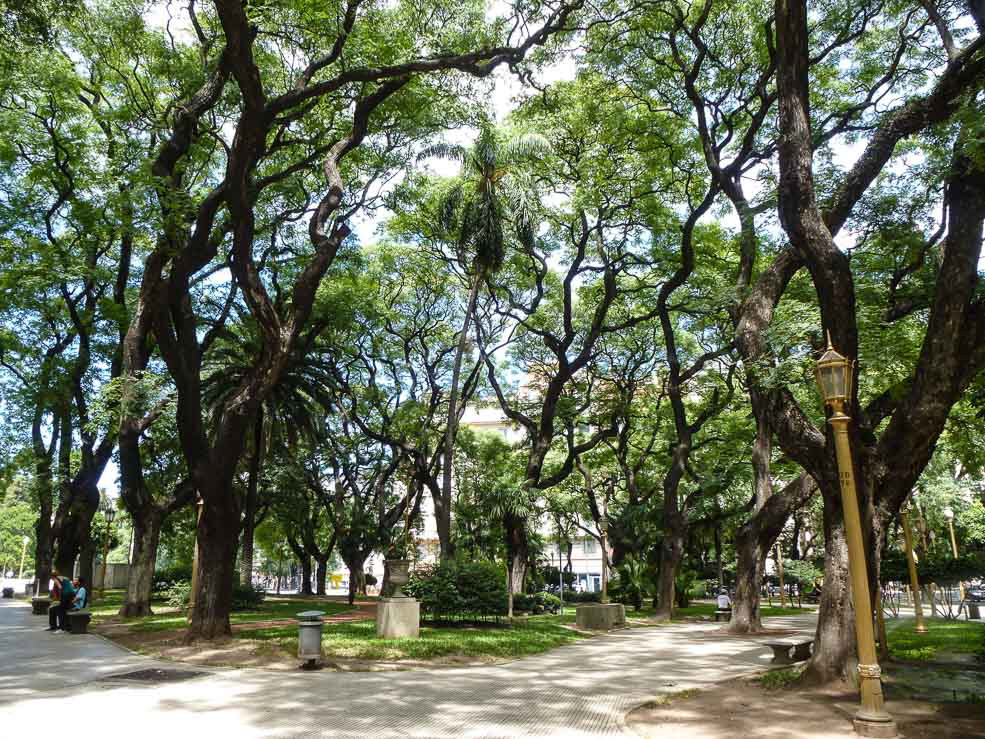
The park embraced almost the entire square. On one side it bordered on a war memorial for soldiers killed in the Falklands War. These memorials can be found in different places and different forms all over Buenos Aires. We later learned that the term “Falklands”, familiar to us, is rather a forbidden “F” word in this part of the world and that it is better - and politically correct – to speak of the “Malvinas”.
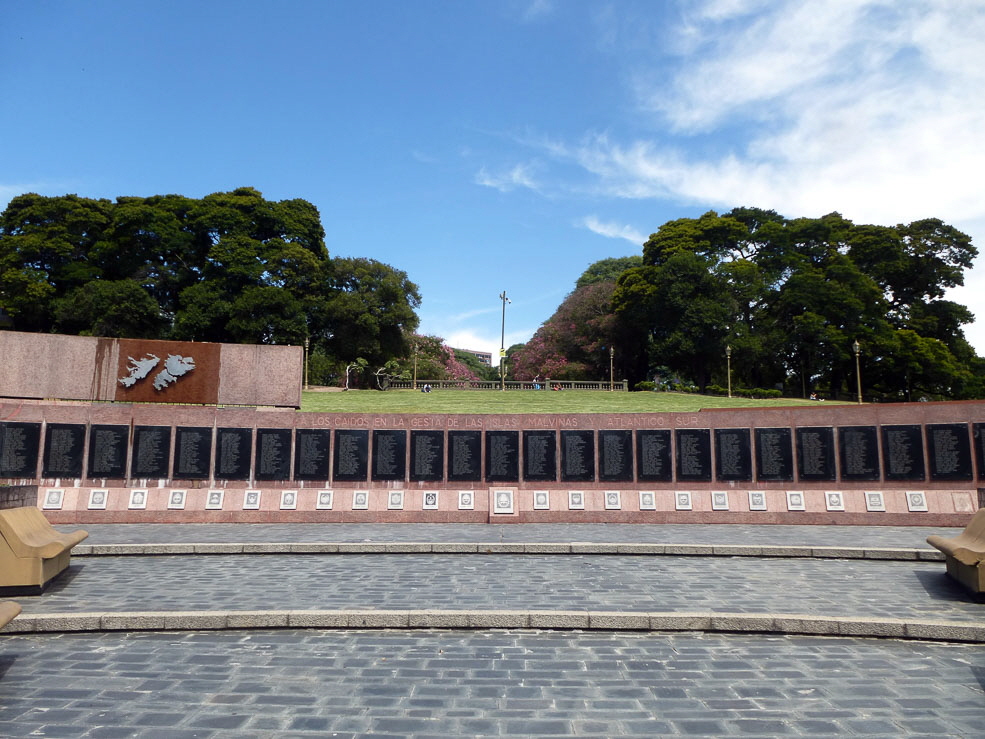
Somewhere else in the square, General San Martin, after whom the plaza was named, sat high on horseback overlooking a flea market which had just closed down but still offered a nice photo opportunity.
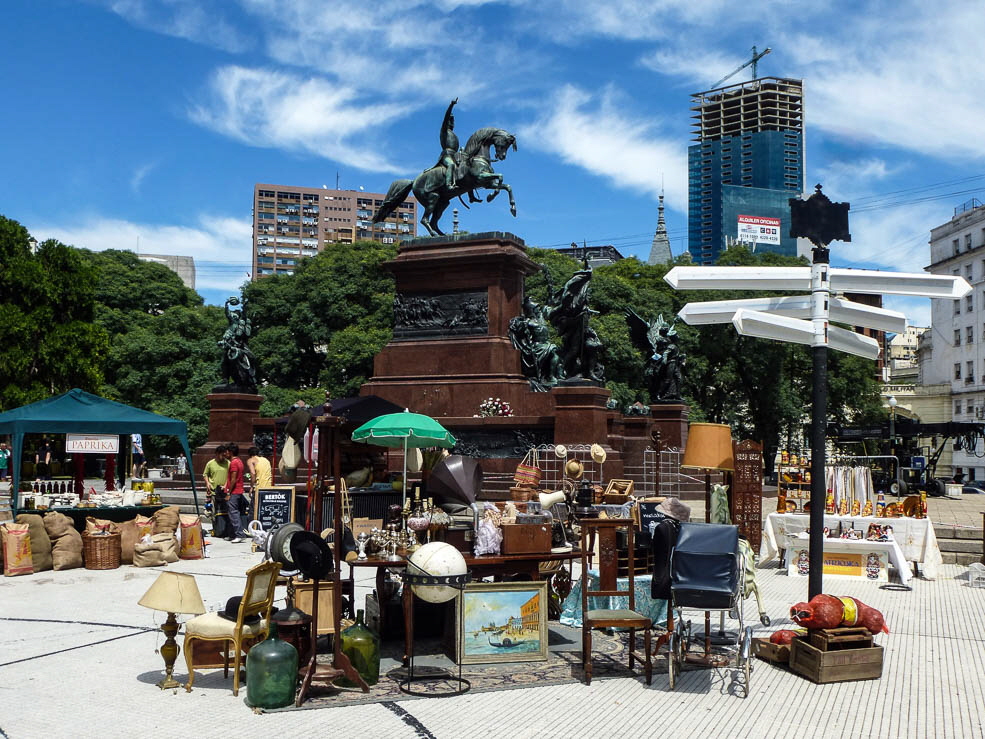
The square marks the beginning of the Retiro district, one of the posher areas of Buenos Aires. Besides ornately decorated buildings full of history it is also home to the old and new buildings of the Ministry of Culture and Foreign Affairs. With the construction of the new building, the architect mastered the feat of melting old and new together, with the stark glass front of the new Ministry reflecting the warm, classical façade of the old building. Despite the architectural difference, both seem like one unit, surprisingly harmonious.
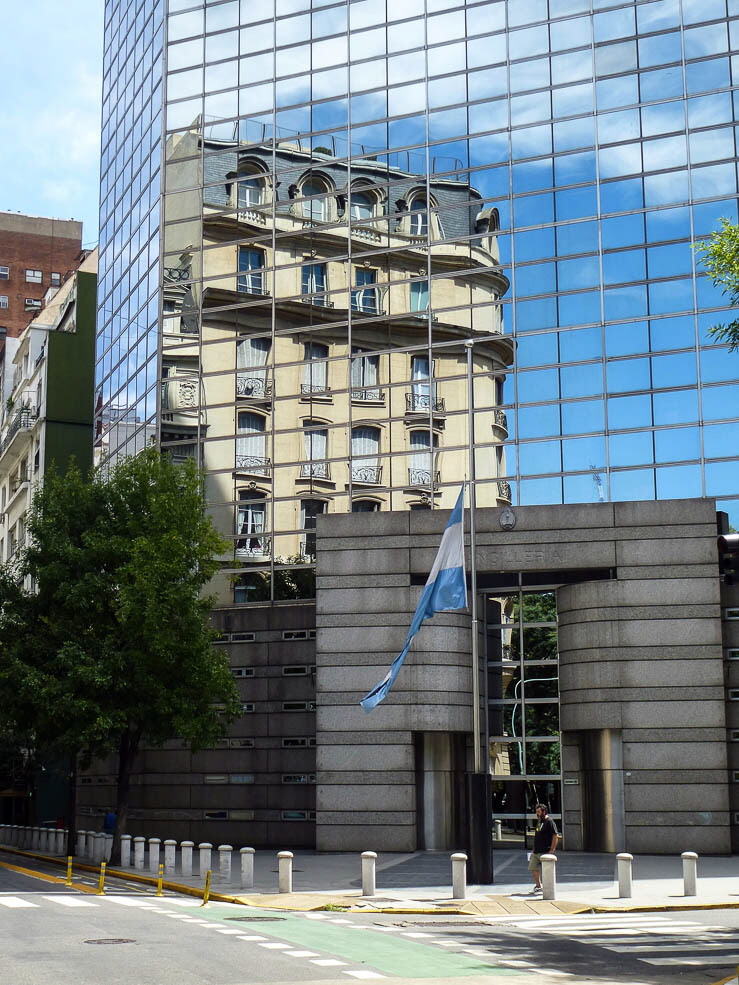
Our way took us past small restaurants, fruit stalls and other shops towards Avenida 9 de Julio, with a width of 140 meters one of the largest streets in the world. 7 lanes each way make it one of the main arteries of Buenos Aires.
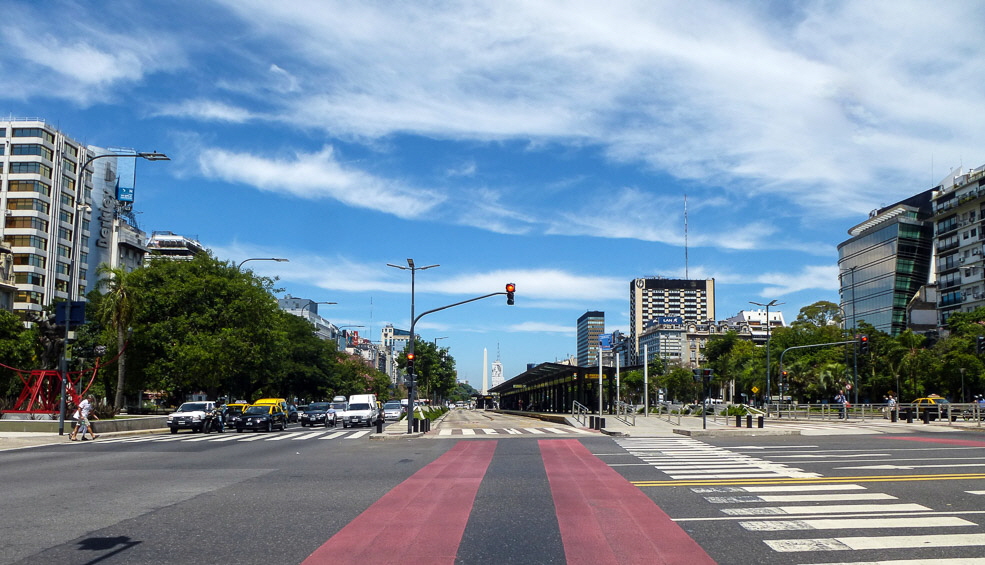
The middle lanes are reserved for public buses, which run past a seemingly endless series of stops. Most of the buses seem modern despite their retro design and often colourful paintings, yet radiating South American flair.
The streetscape is dominated by an obelisk and the building of the Department of Health.
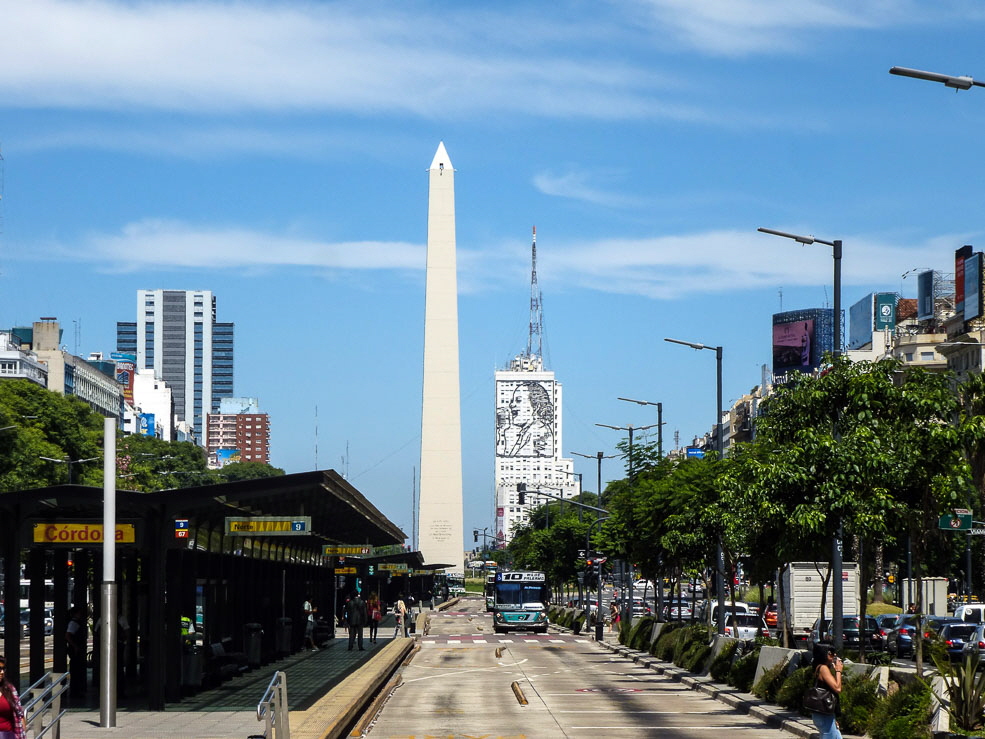
When the boulevard was built in 1936, whole blocks were razed to the ground. Only by tricks was it possible to save a few classical and historical buildings from demolition, e. g. by transforming them into embassies and thereby into exterritorial areas. The obelisk, visible from afar, marks the former location of a church on Plaza de la Republica, which also fell victim to the bulldozers during the Avenue’s construction.
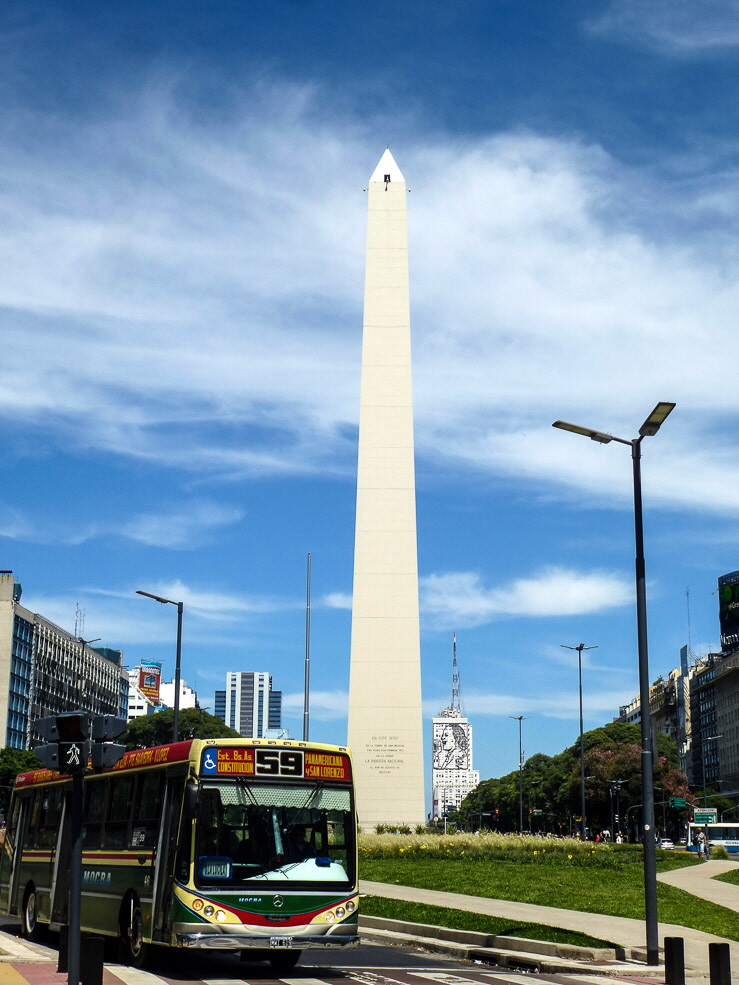
10 storeys high, a portrait of “Evita” Eva Peron adorns the mighty concrete tower of the Department of Health. It seems as if Evita is still speaking to the people of Buenos Aires through the microphone.
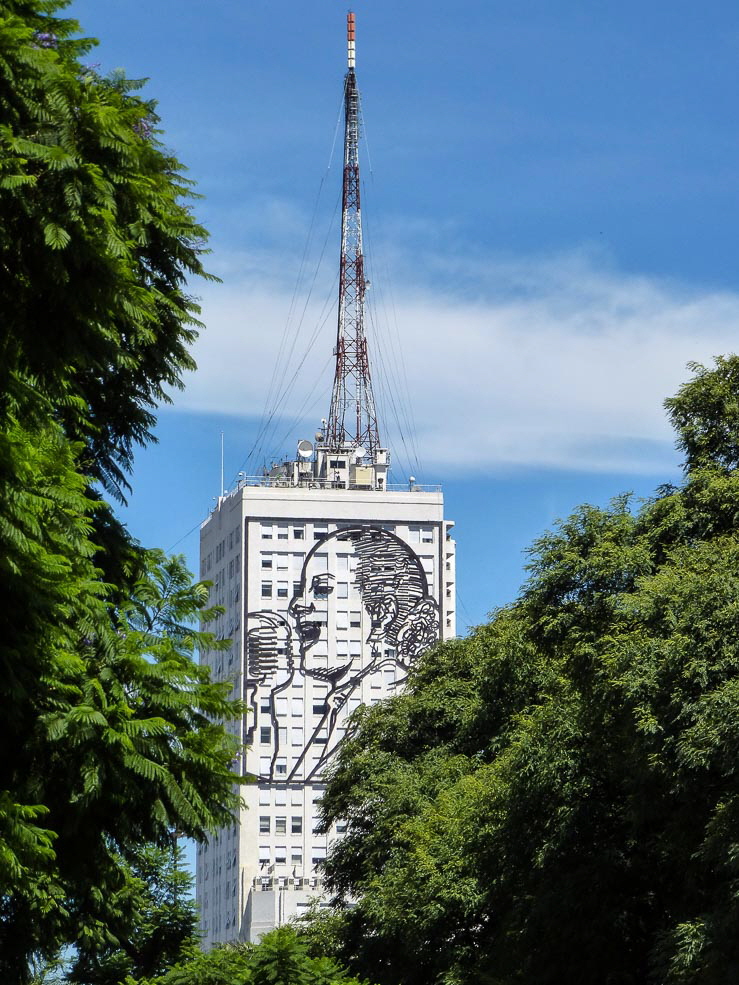
In the meantime, the temperatures had gone up, so the delicate spray of a monument representing the Iguazu Falls was just the right stop at the right time.
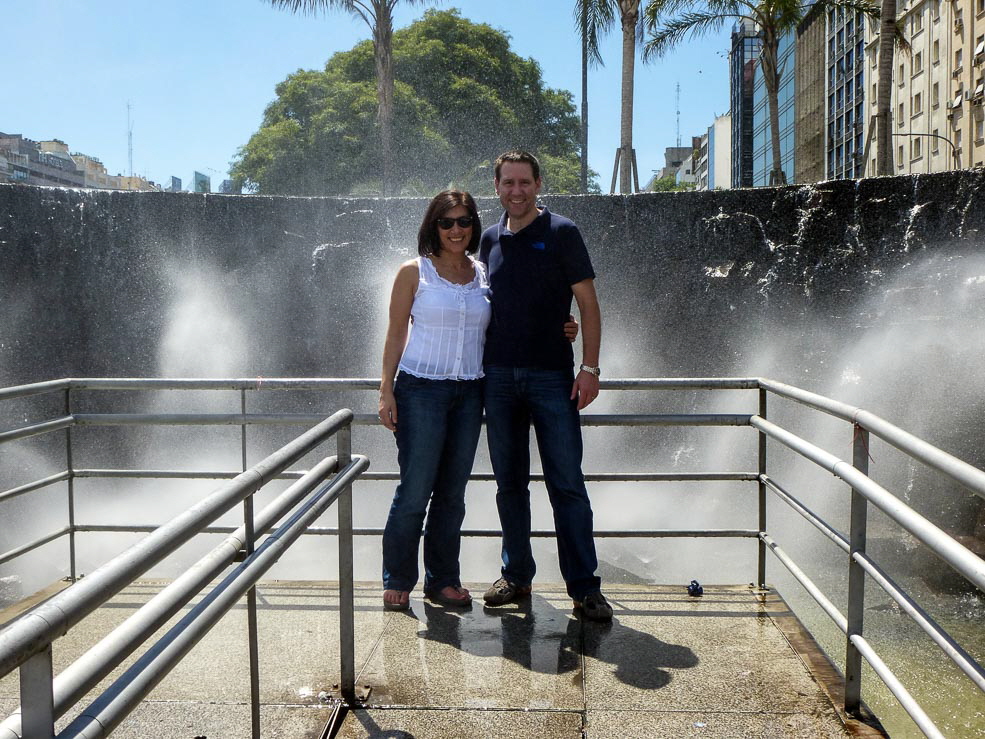
This picture also shows that we were out on light luggage. During our research on Buenos Aires we frequently came across crime warnings and cautions against the omnipresent pickpockets and tricksters. We heard from a few fellow travelers that they had the unfortunate honor of such encounters.
Our precaution was simple and apparently very effective – we simply didn’t take any valuables with us. A few dollar bills in our pockets, my small old camera instead of the expensive DSLR, no mobile phone and nothing else which somebody else might find attractive or which could make us a worthwhile target. What you don’t have can’t be taken from you, and so we walked the streets of Buenos Aires carefree and unchallenged.
At the height of the obelisk we turned left into Avenida de Mayo where we saw the frist examples of street art, of which we would admire many more throughout the city.
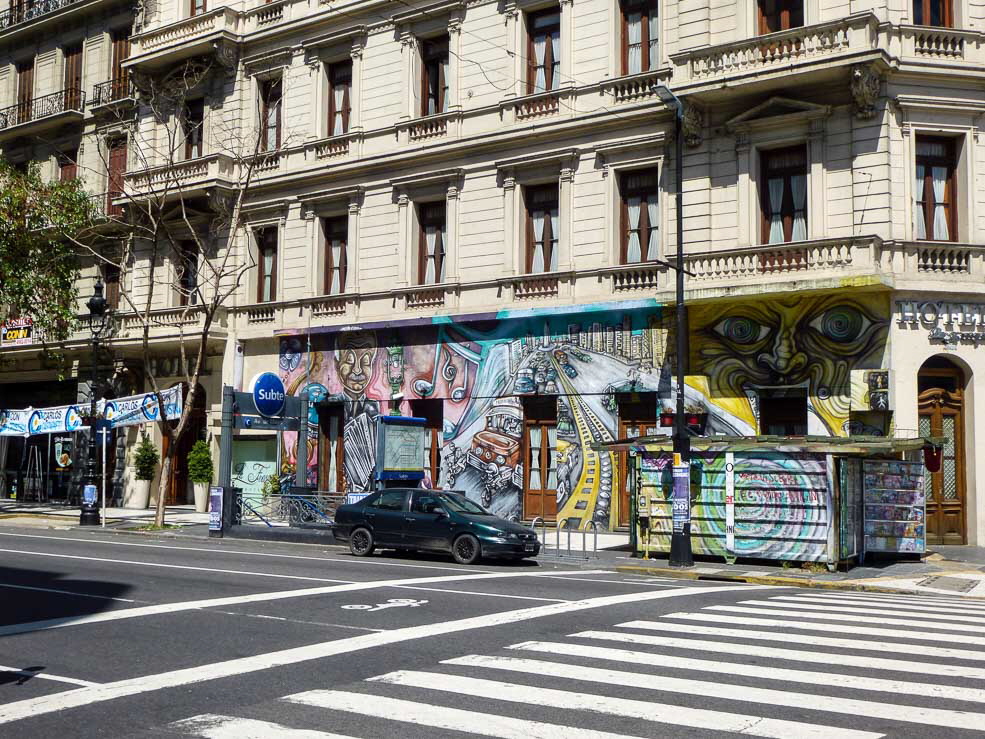
On Avenida de Mayo we felt like walking along the boulevards of Paris. Stucco facades, wrought-iron balconies and trees lining the street rather radiated an old, classical European flair than reminding us that we were exploring a South American metropolis.
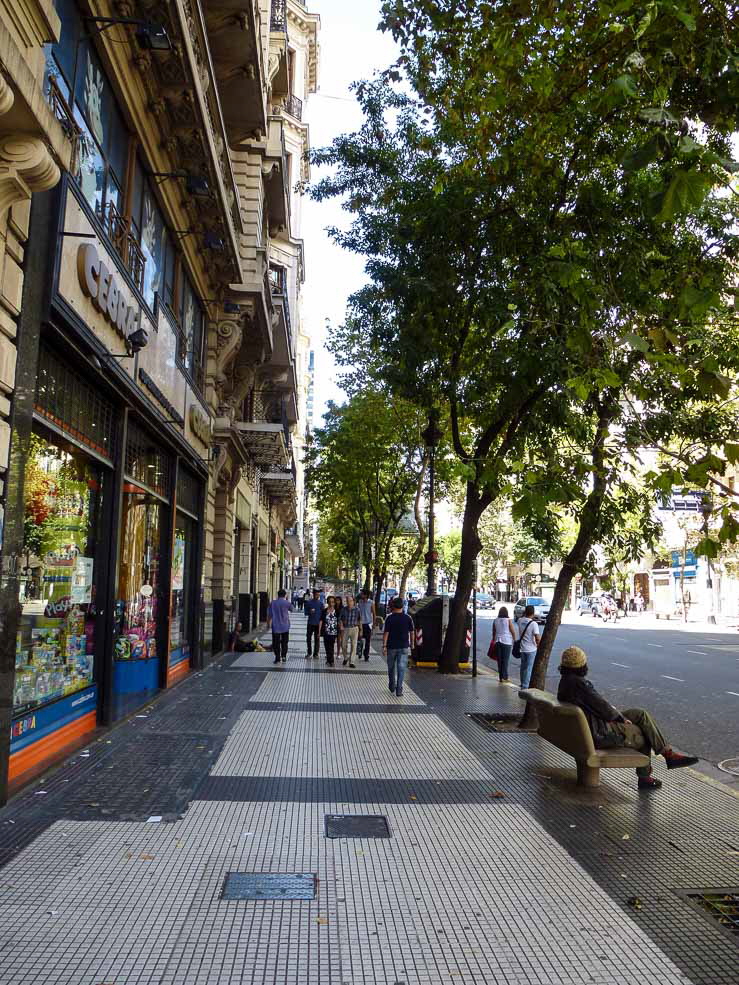
We also passed Café Tortoni. As one of Buenos Aires’s oldest Cafés it hosted many celebrities and intellectuals througout the years and also survived some of the less attractive eras of Argentina’s political history. Today it stands as a symbol of the “Porteño Café”, “Porteño” being the name of the residents of Buenos Aires.
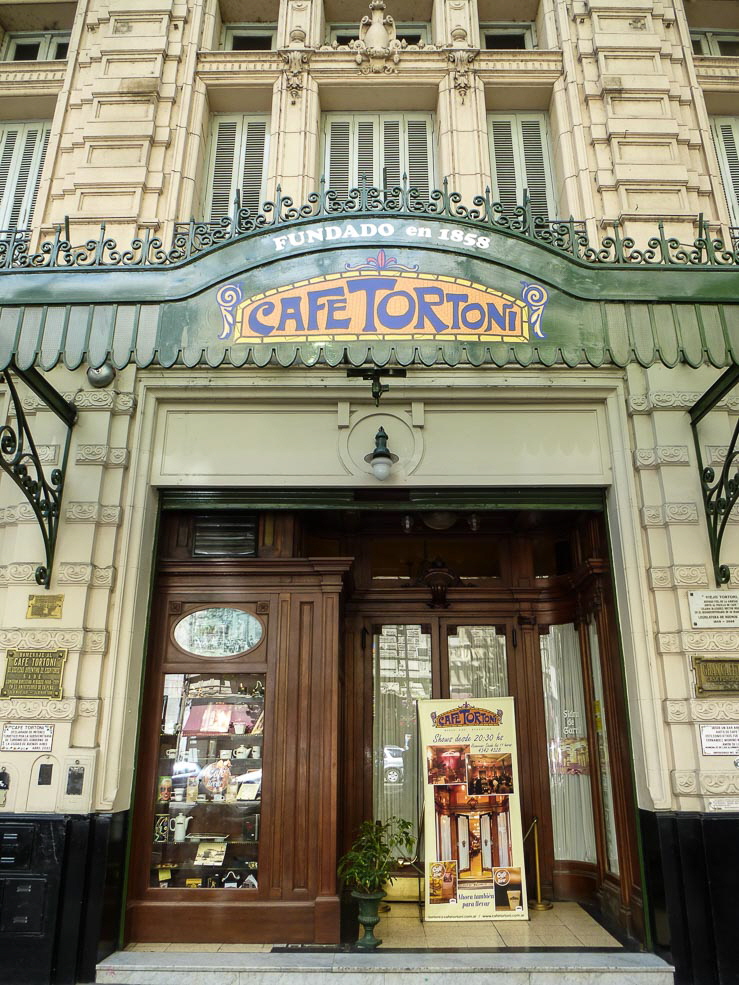
Since Café Tortoni would be part of our guided walking tour two days later, we skipped a visit inside. We decided to turn into Calle Peru, a little side street before Plaza de Mayo, taking us towards San Telmo. Today San Telmo is considered the oldest and most original part of Buenos Aires. It is often described as the “cradle of tango”.
This little side street offered a completely different impression compared to the European-like Avenida de Mayo. Old house fronts in various states of maintenance mixed with more recent buildings, rusty delivery trucks and colourful inscriptions on the cobblestone made it look like a street from a different world – maybe a world which corresponded more to the ideas we had of South America.
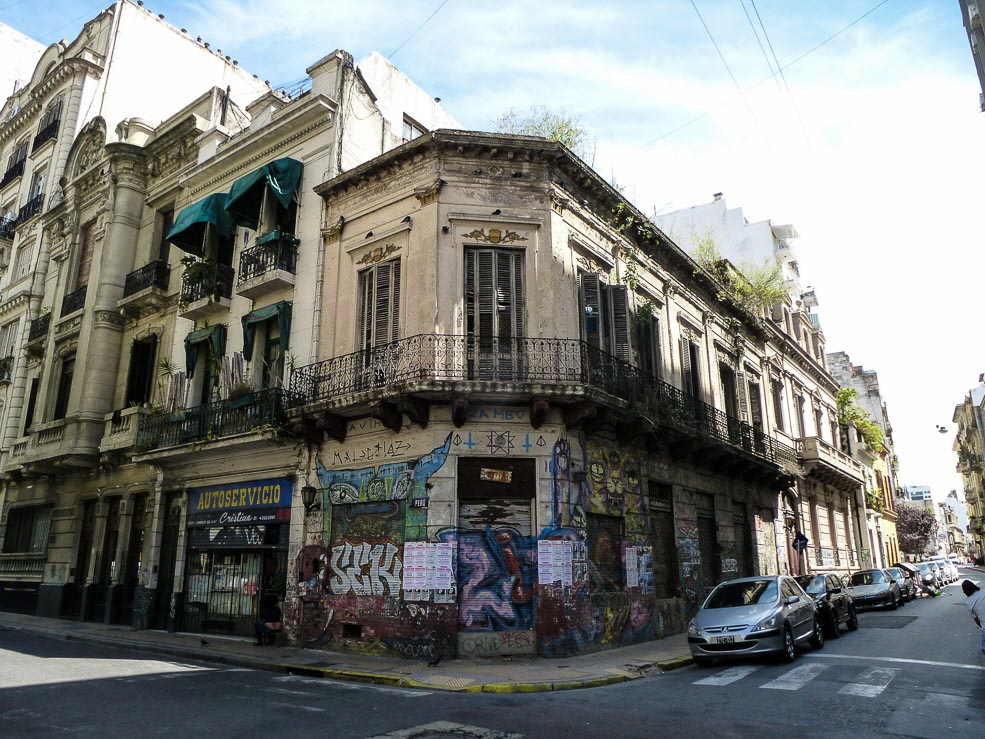
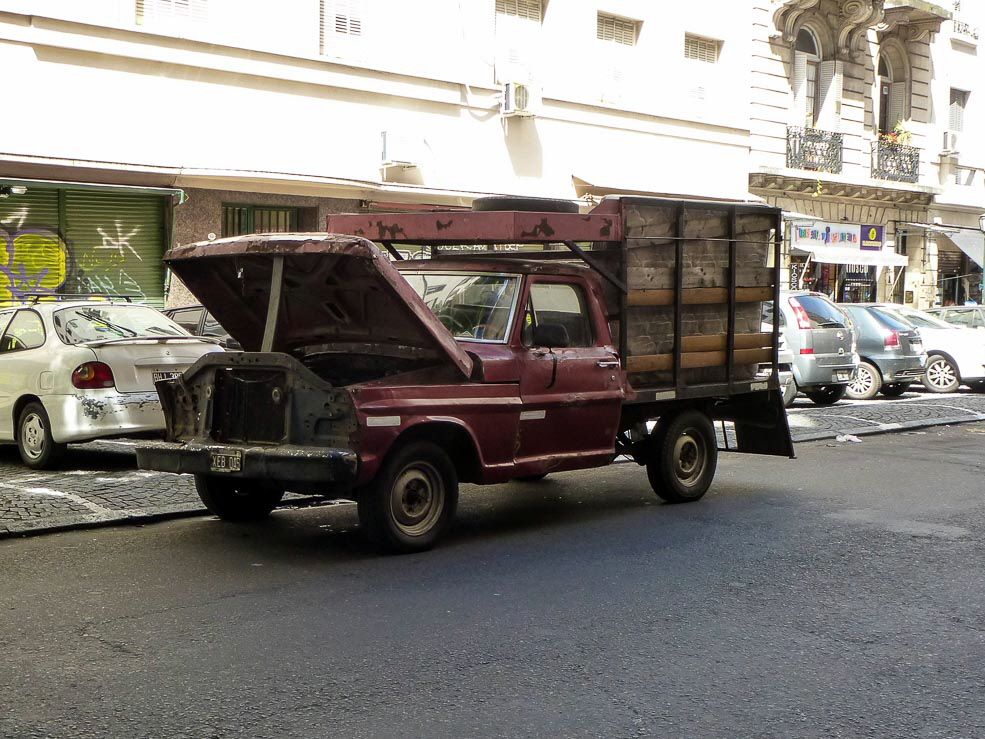
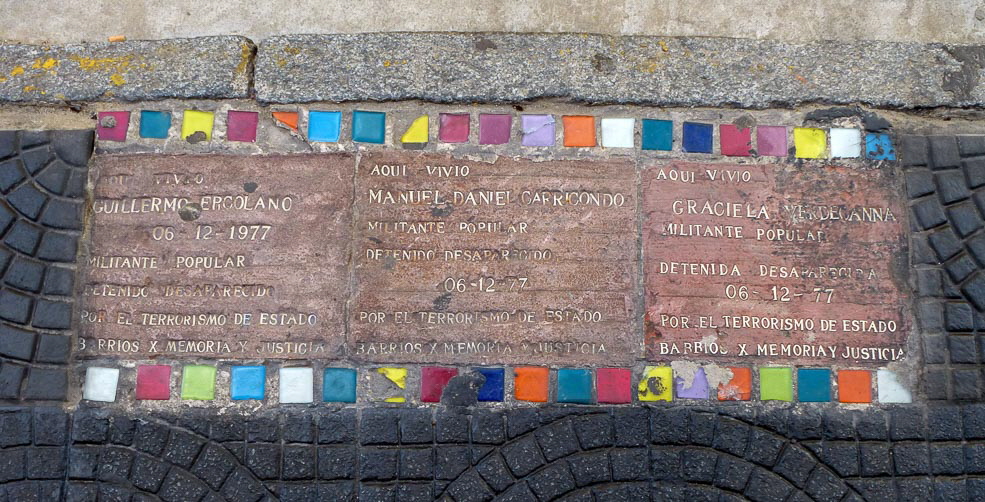
At a crossroads where we meant to turn towards San Telmo we came across an inviting little bar where not only tourists but also locals and four-legged residents were having a break and enjoyed the hospitality.
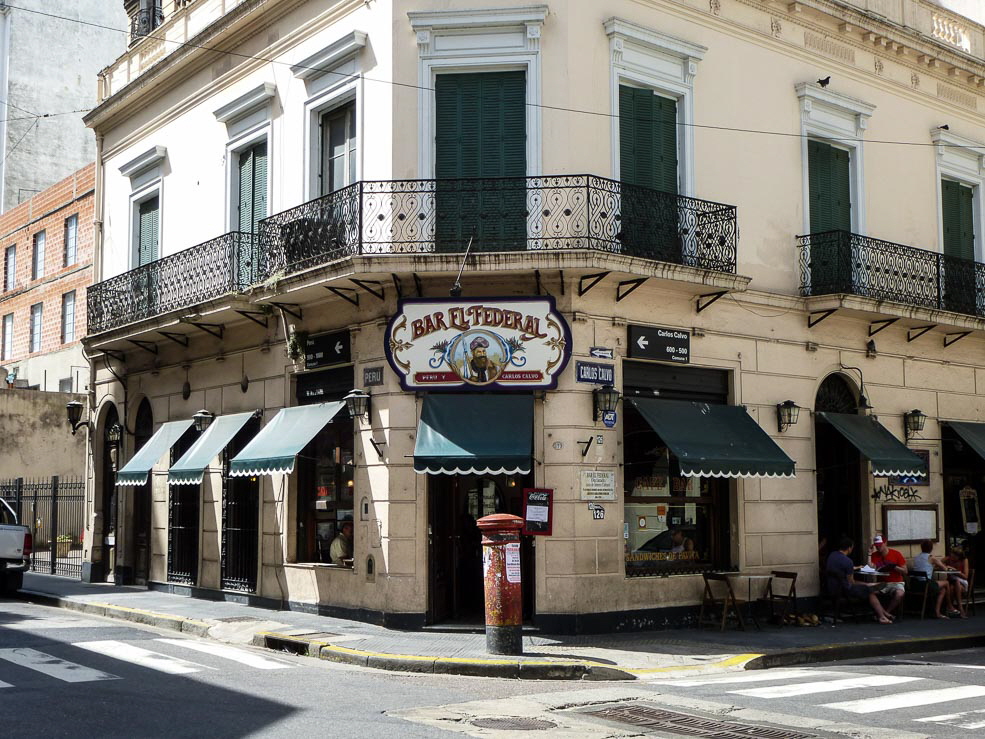
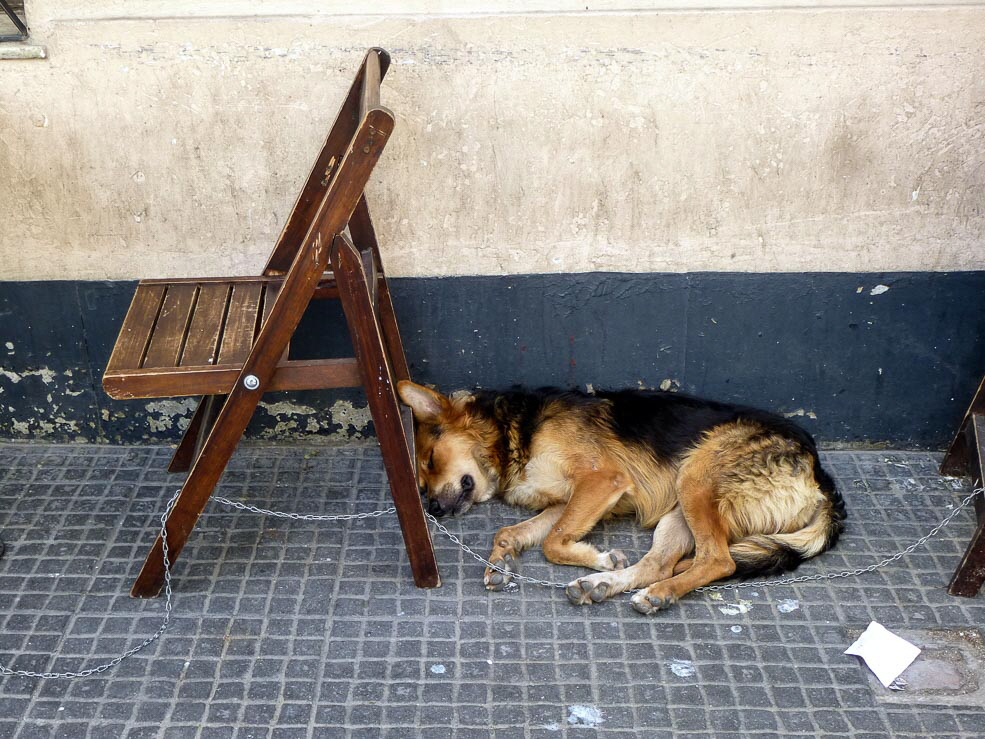
We felt like doing the same... We hadn’t quite sat down when a friendly waiter was already at our side to take our orders: a cool home-brewed beer for Birgit and a cappuccino for me. Unfortunately, none of the microbrewed brands meant anything to us, which made the choice a little difficult for Birgit. The waiter just smiled, and when he returned with my cappuccino, which is traditionally served with a glass of water and a piece of cake, he simply gave her 3 little samples to try. If there had been any doubts, now it was clear: quadrupeds can’t be wrong. We had found a very hospitable place.
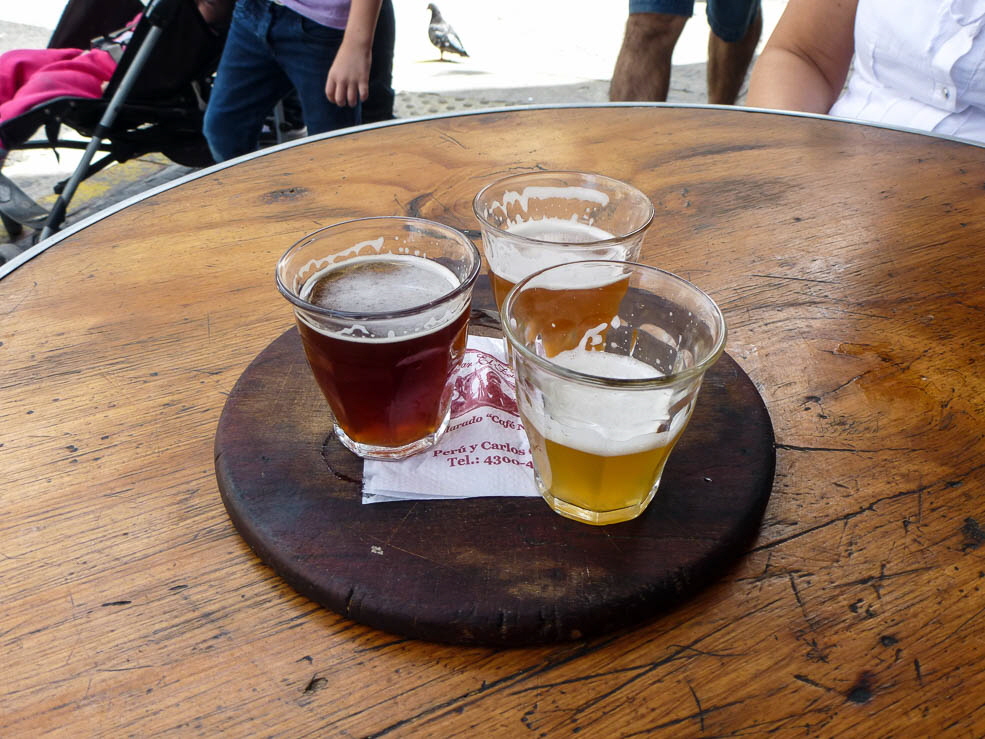
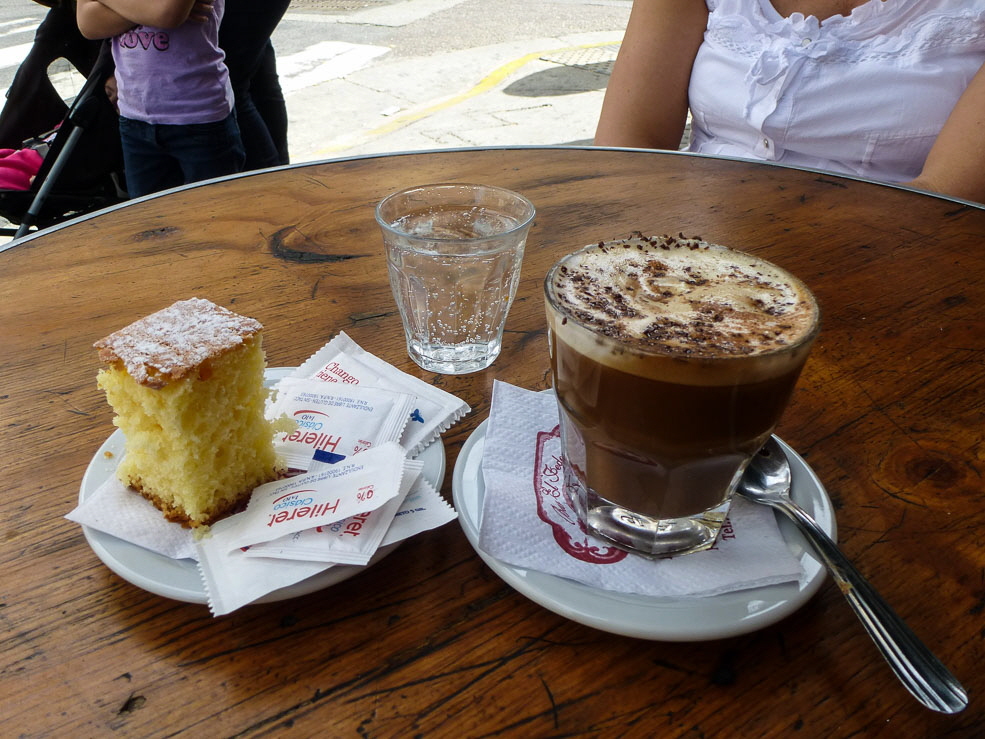
After Birgit had finished a proper glass of beer and we had paid with a 10 dollar bill, we continued on our way invigorated and positively impressed.
An archway with the inscription “San Telmo Mercado” indicated that we had reached our first destination. The entrance led to an old covered market with ornately decorated iron beams and a central glass dome through which the light shone on a colourful world of fruit and vegetable stalls, butchers and antiques shops.
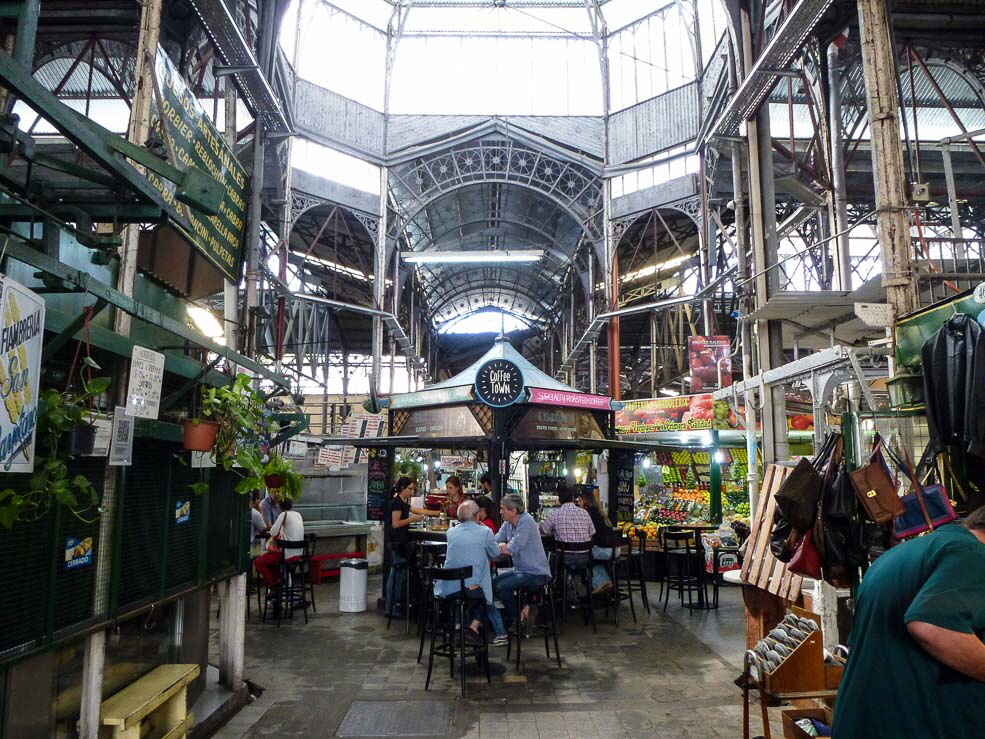
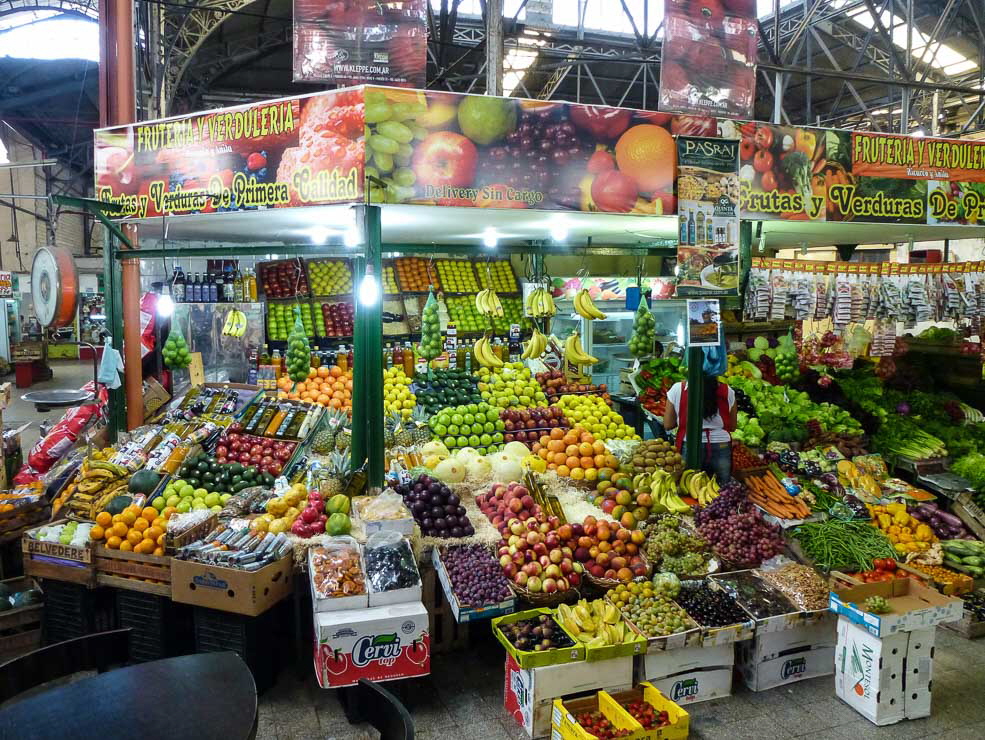
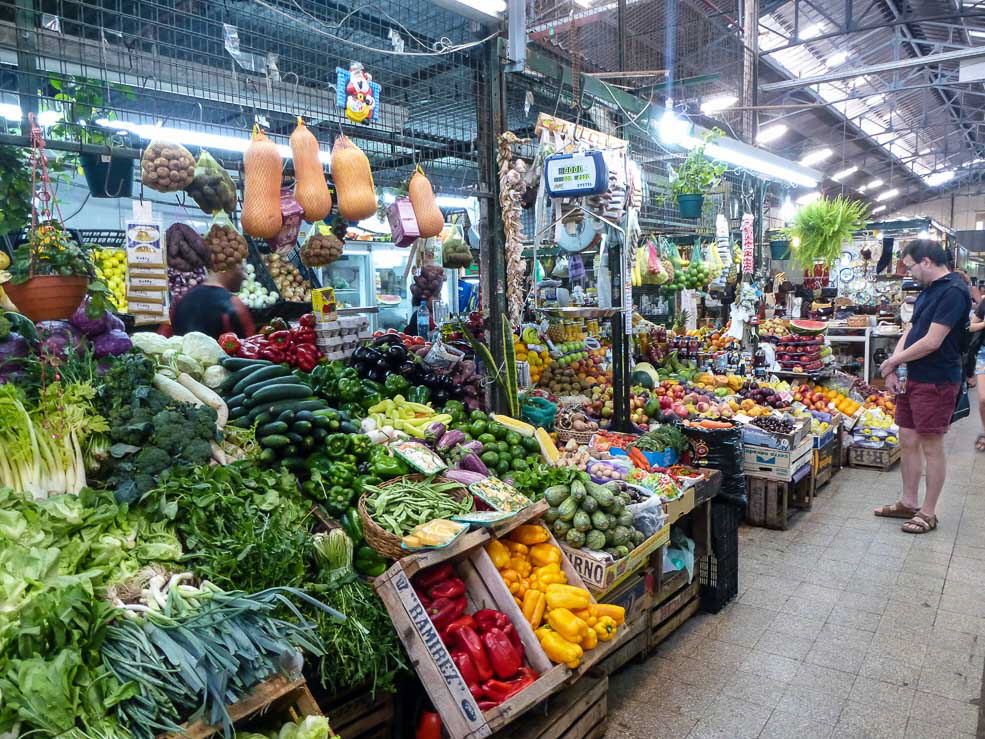
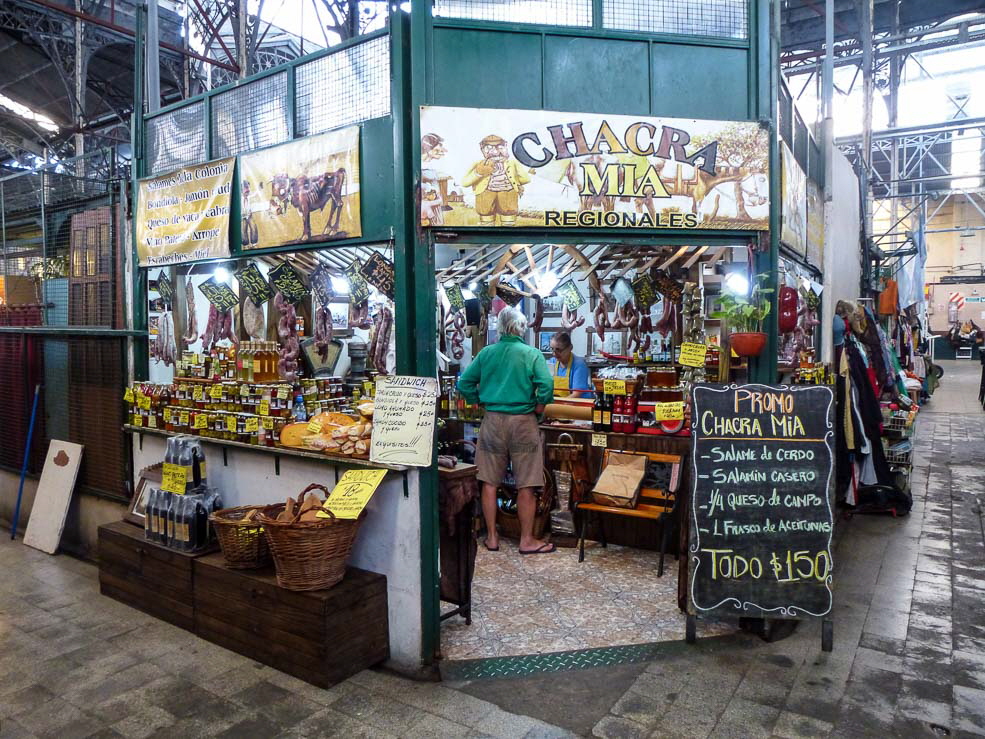
The different shops were a heaven for lovers of old records as well as for collectors whose heart would skip a beat at the sight of old magazines or tin toys.
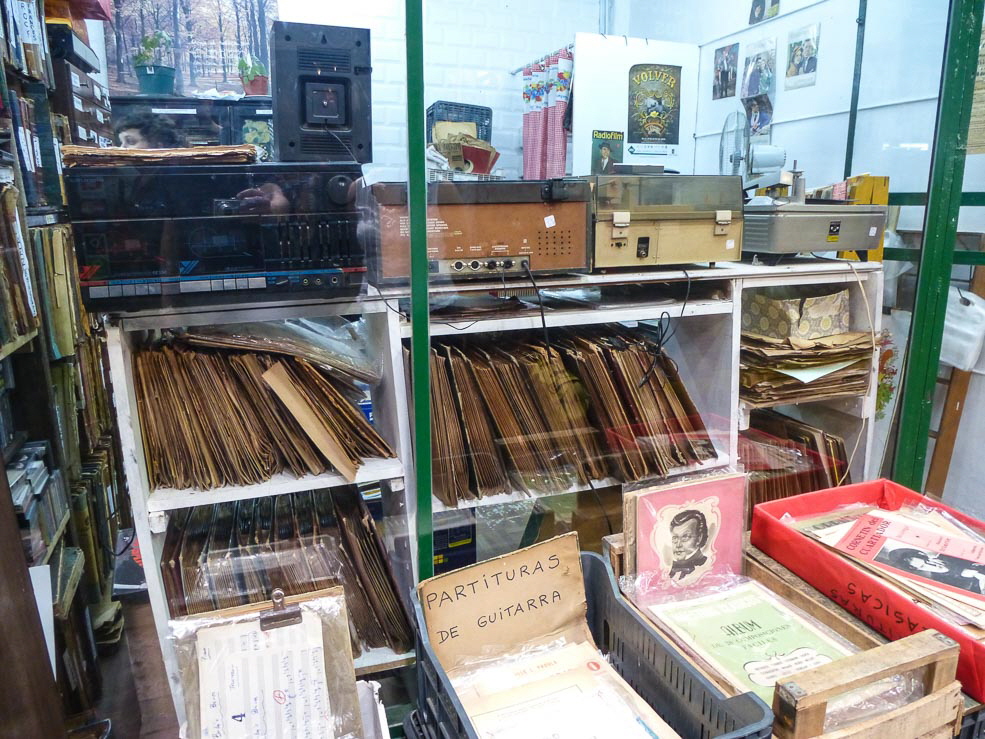
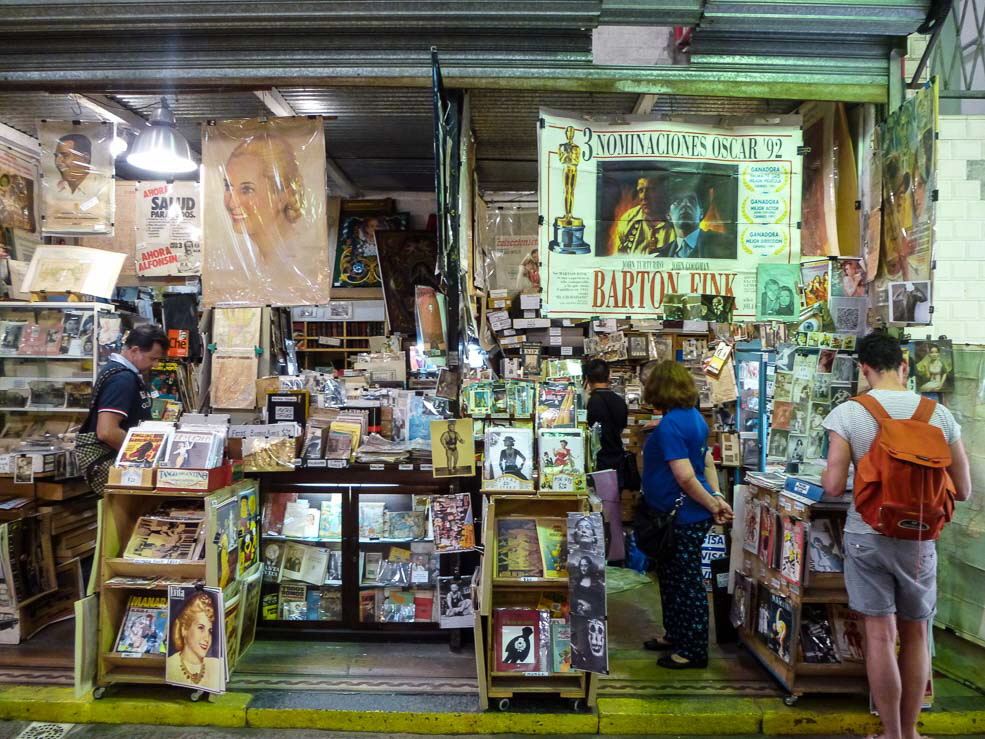
When we left the market, still fascinated by the atmosphere of the place, we found our first asado in a converted garage, which exuded an extremely tempting smell of barbecue. The price (here the $ sign stands for Pesos) was as tempting as the smell. But as we planned to go for a meal later in the day, I forced myself not to let my carnivore instincts take over.
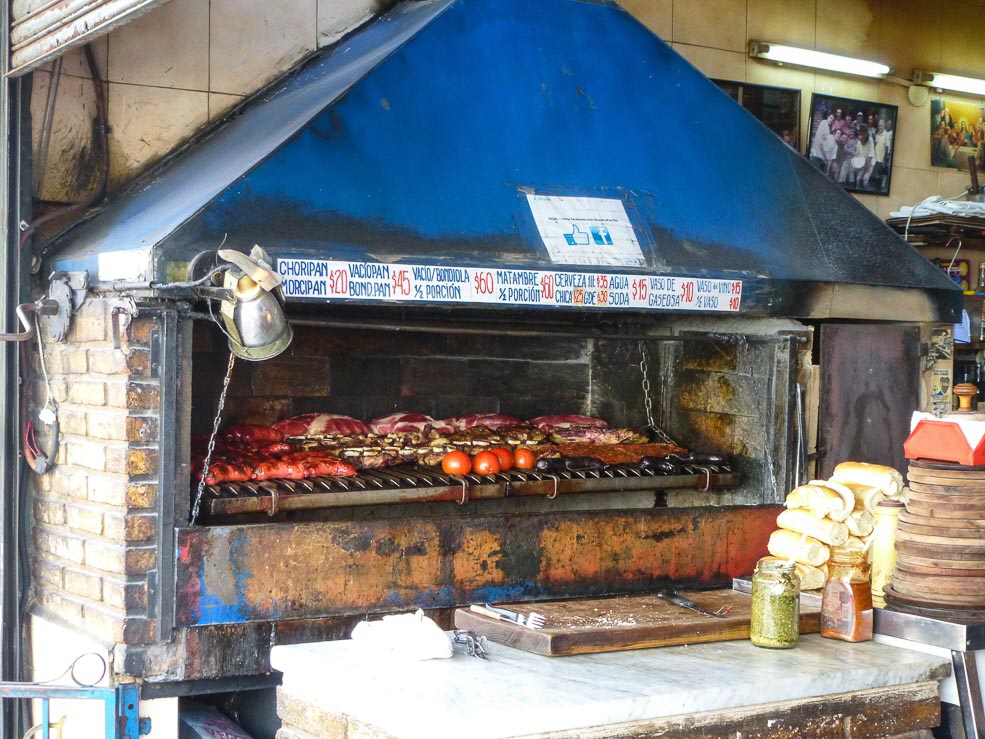
To return to our hotel we took Defensa street, which displayed more of the interesting street art with which artists had immortalized themselves on some of the houses.
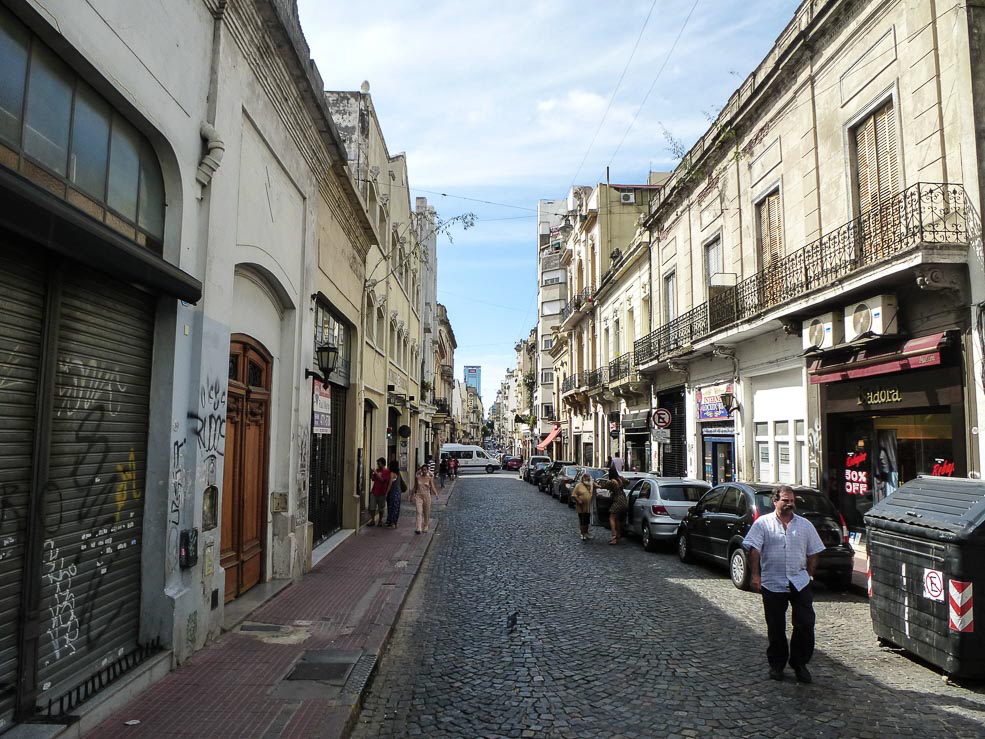
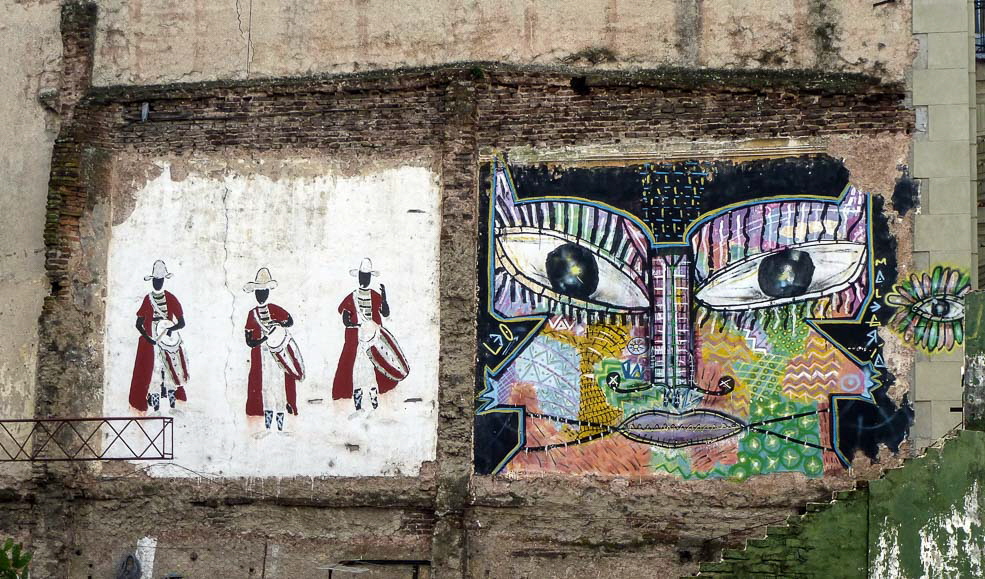
At a crossroads, little Malfalda, a famous Argentinian cartoon character, waited with her friends on a bench to let the hearts of passers-by beat faster – and not only those of children.

From the top of the basilica San Franciso, a kneeling Christopher Columbus together with Giotto and Dante Alighieri looked down on the oldest pharmacy in the city. A glance into the still open “Farmacia de la Estrella” from 1885 is like a glimpse into the past. The decor of dark walnut wood and the old paintings both on the ceiling and the walls of the pharmacy are still preserved in their original state.
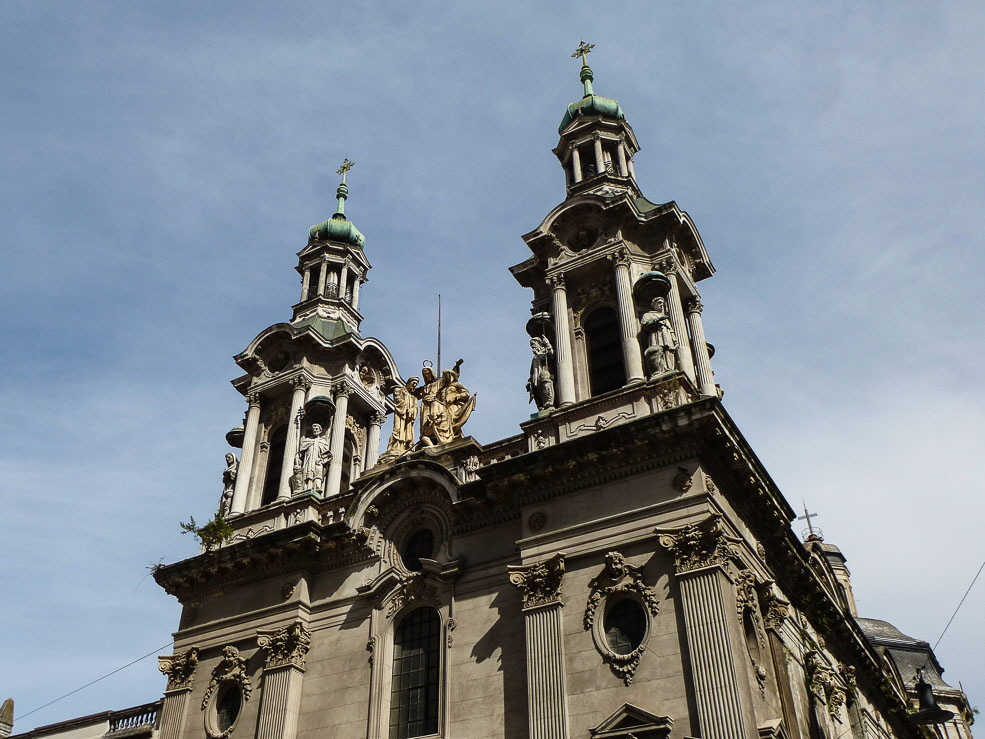
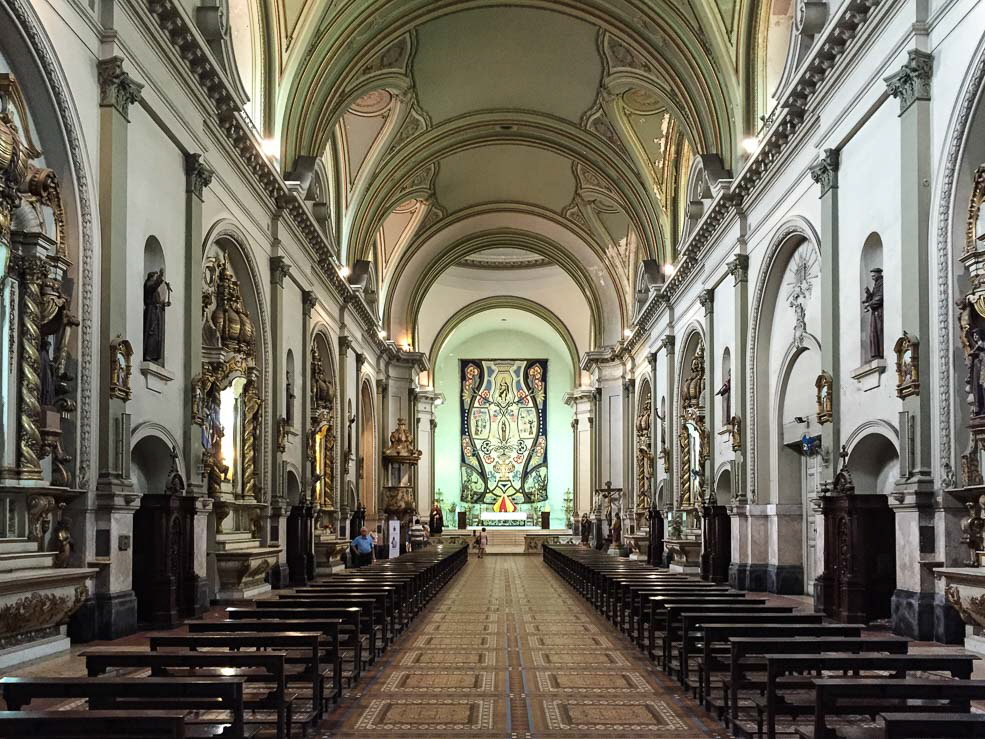
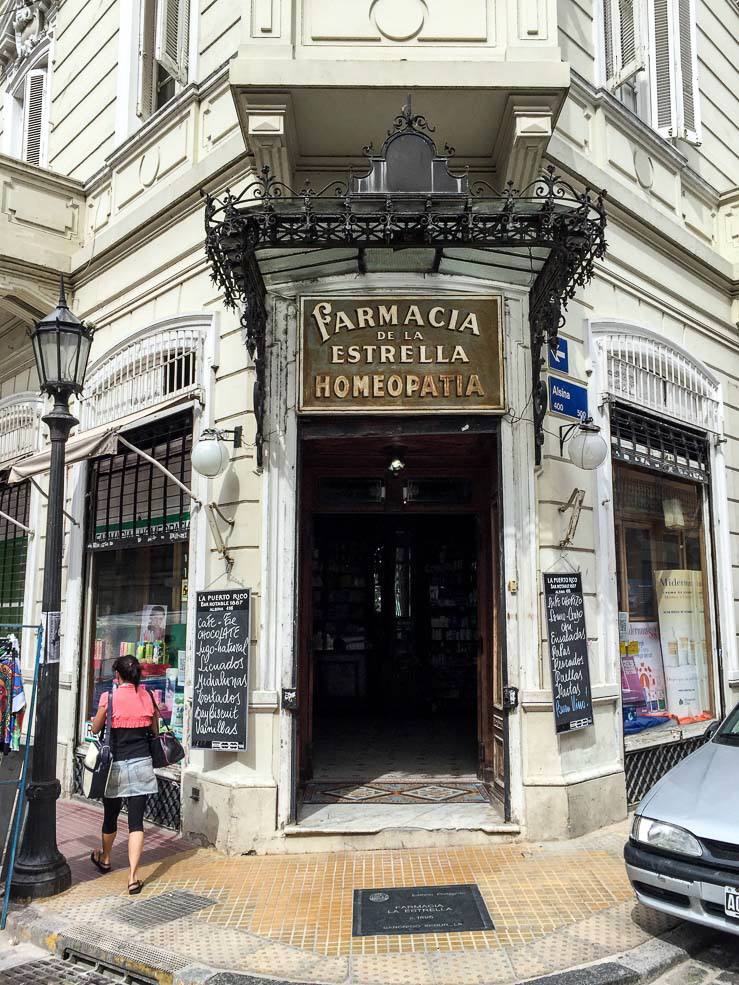
The nearby Plaza de Mayo (Square of the May Revolution) represents the heart of the city. The square was the founding core of the City of Buenos Aires and is named after the month of liberation, in which Argentina gained its independence from Spain in 1810.
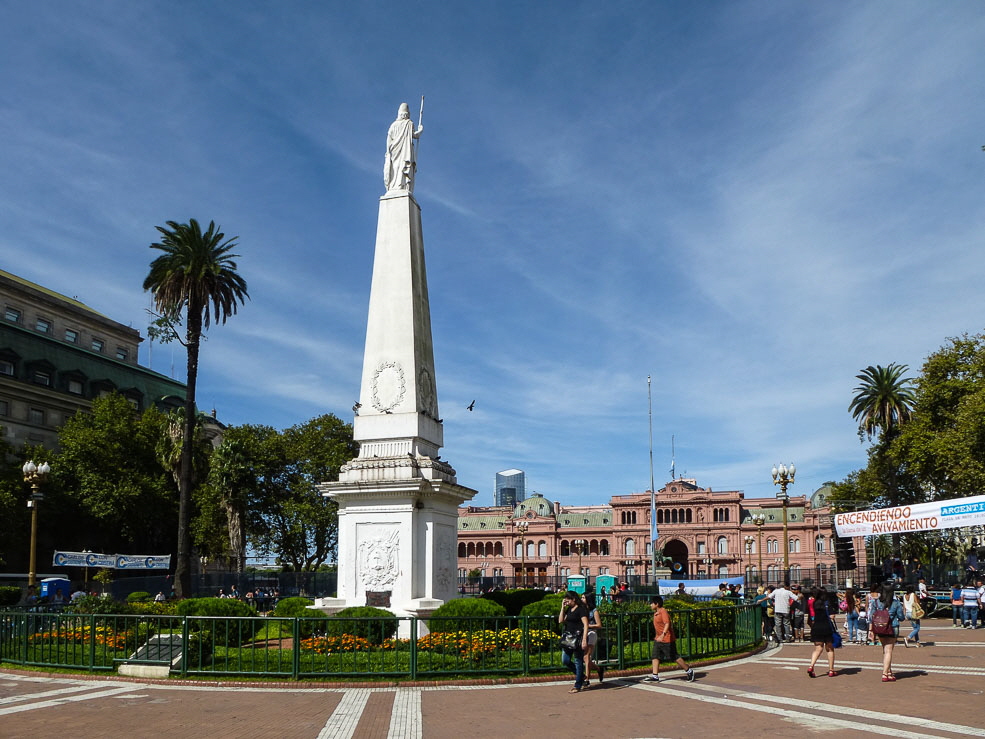
The Madres de Plaza de Mayo (Mothers of the Square of the May Revolution) brought worldwide fame to the square when, during the military dictatorship (1976 – 1982), they marched silently around the square to protest against the disappearance of their sons and daughters. As they marched, their action couldn’t be considered an illegal gathering, and since they remained silent, it didn’t qualify as a protest.
During this dark time of Argentina’s history some 30,000 people disappeared without a trace. Only later was it revealed that they were tortured and murdered during the dictatorship.
The square is surrounded by some important buildings. The seat of government, “Casa Rosada”, the National Bank, the historical seat of the former Viceroy and the city’s cathedral.
Of course it wouldn’t be complete without a memorial in honour of the soldiers who died in the Malvinas War.
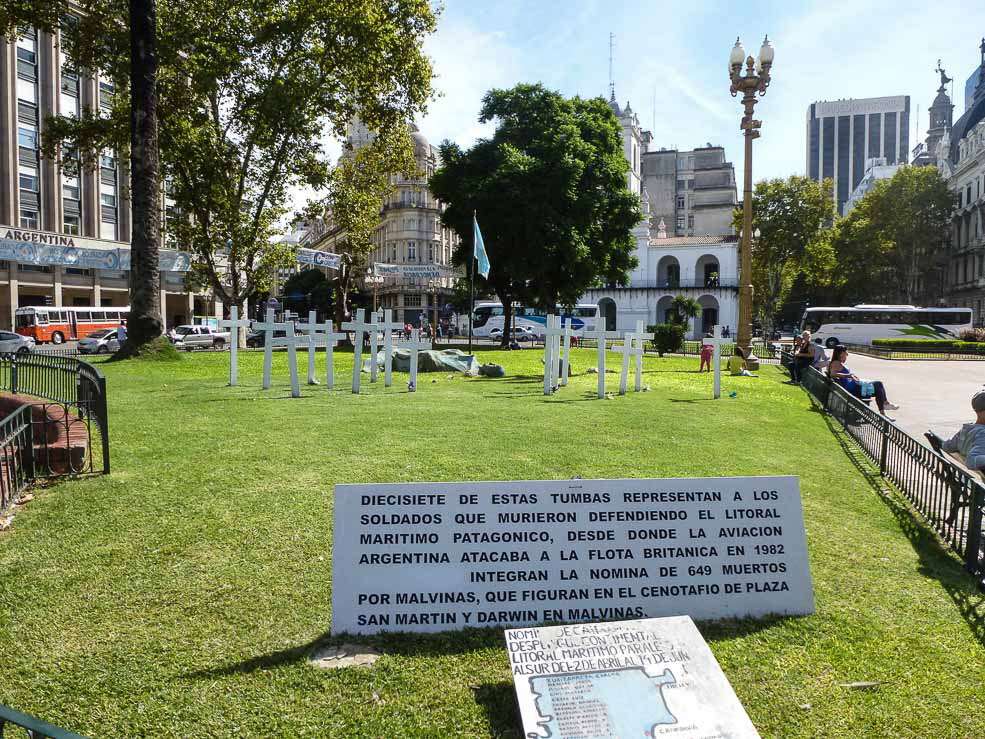
Not only is the cathedral “Catedral Metropolitana” the final resting place of General Jose de San Martin, but it is also the current Pope’s previous place of work, as this is where he had his seat as Archbishop.
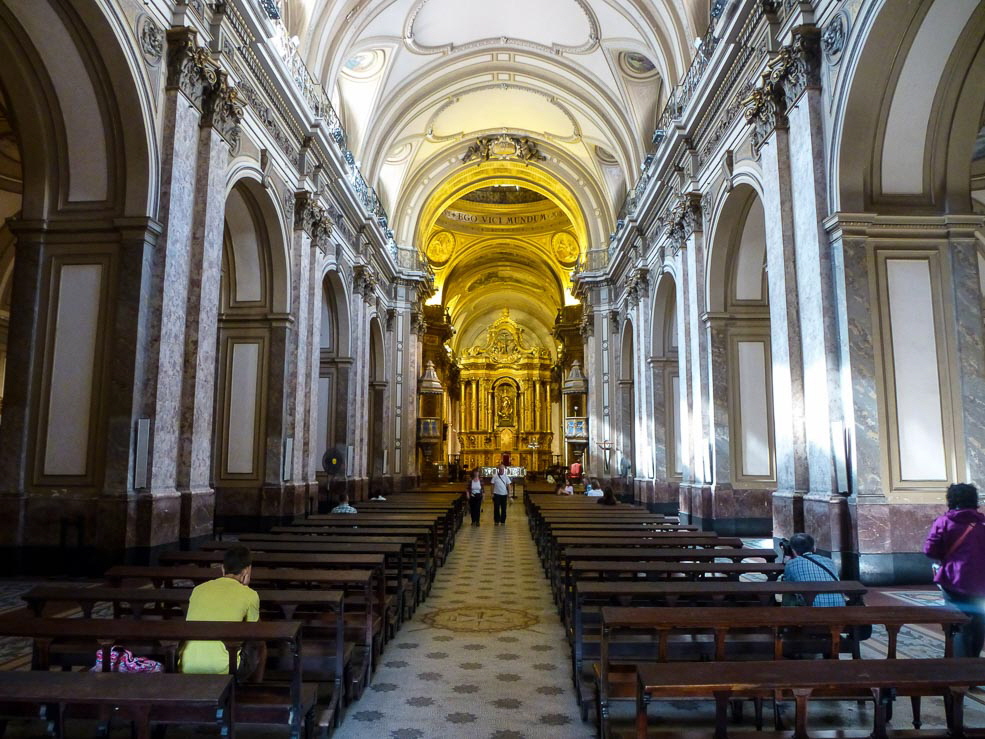
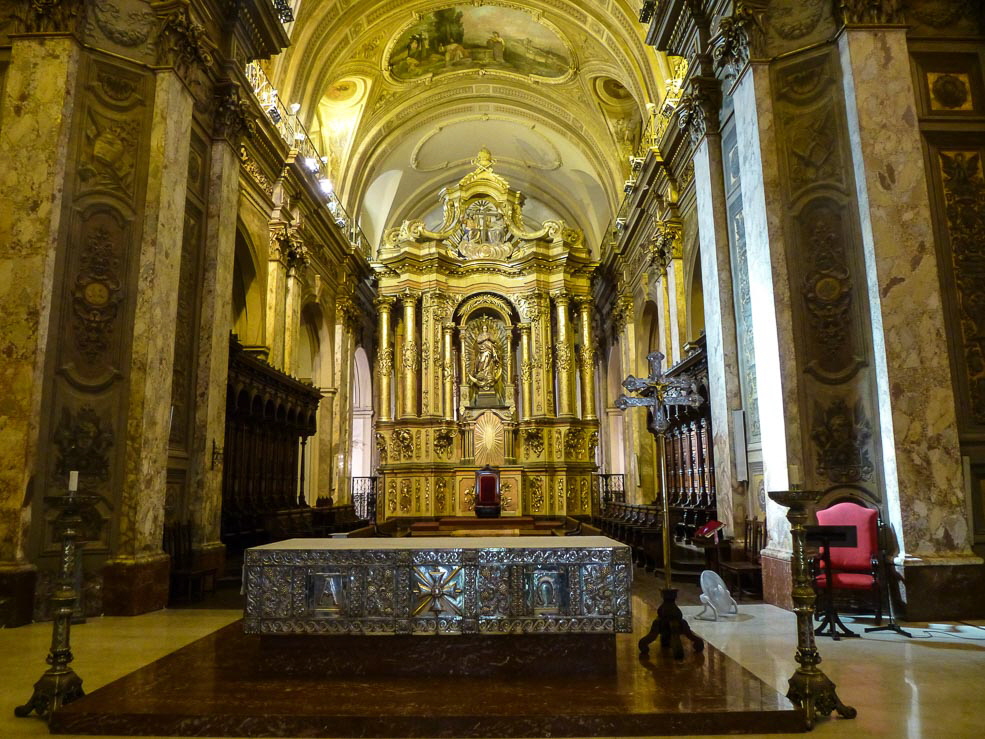
A former Spanish officer, General Jose de San Martin was strongly committed to the pursuit of independence of the Spanish colonies in South America. At the head of a deployed army he defeated the Spanish in various countries on the continent, which is why also in Argentina he is seen as the country’s fatherfigure. He died in 1850 in the north of France. His mortal remains were taken to Buenos Aires in 1880 and buried in a mausoleum inside the cathedral.
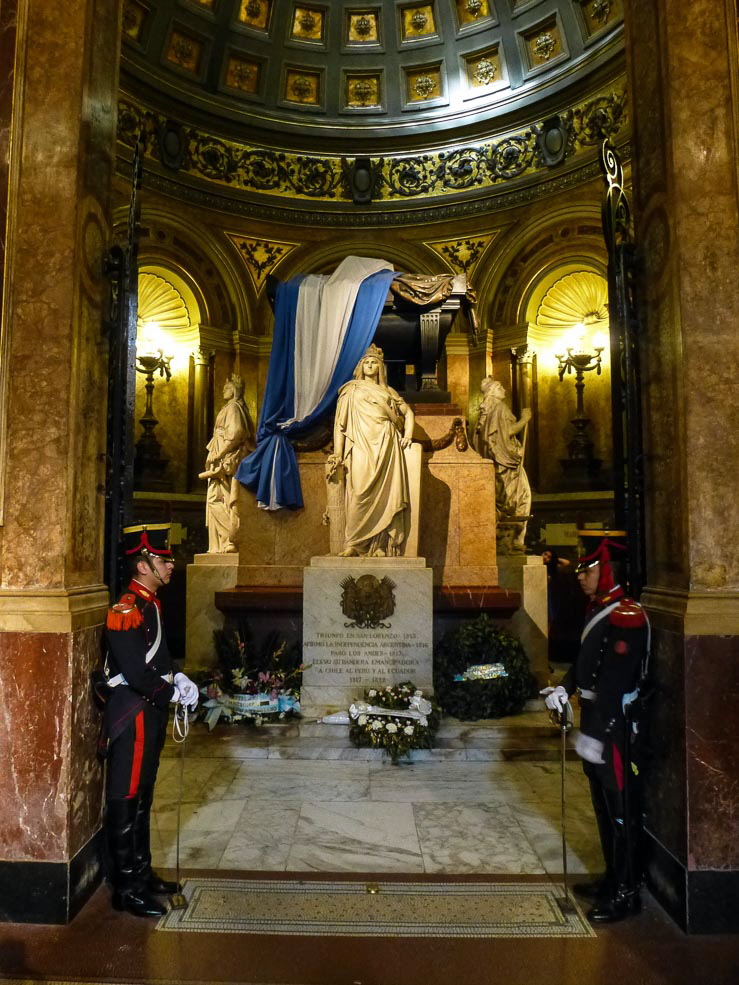
One block further down, the street connected with the southern end of Calle Florida. We had hardly entered the pedestrian zone when the already familiar “Cambio, Cambio, Cambio...” reached our ears. Especially from book and flower stalls in the middle of the street. We were wondering whether they were actually selling any books or flowers.
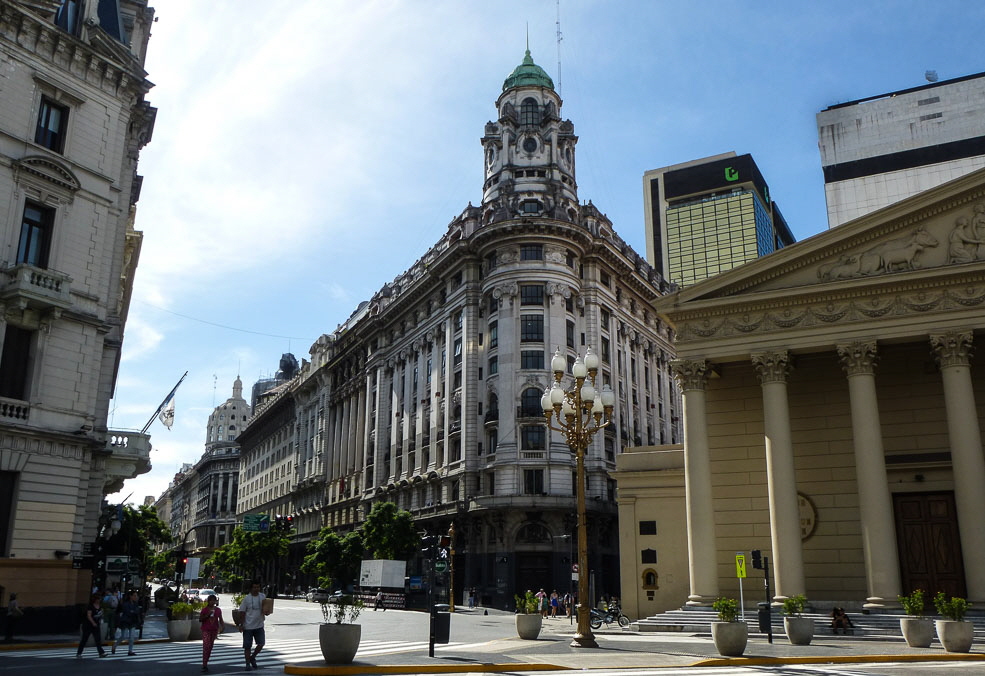
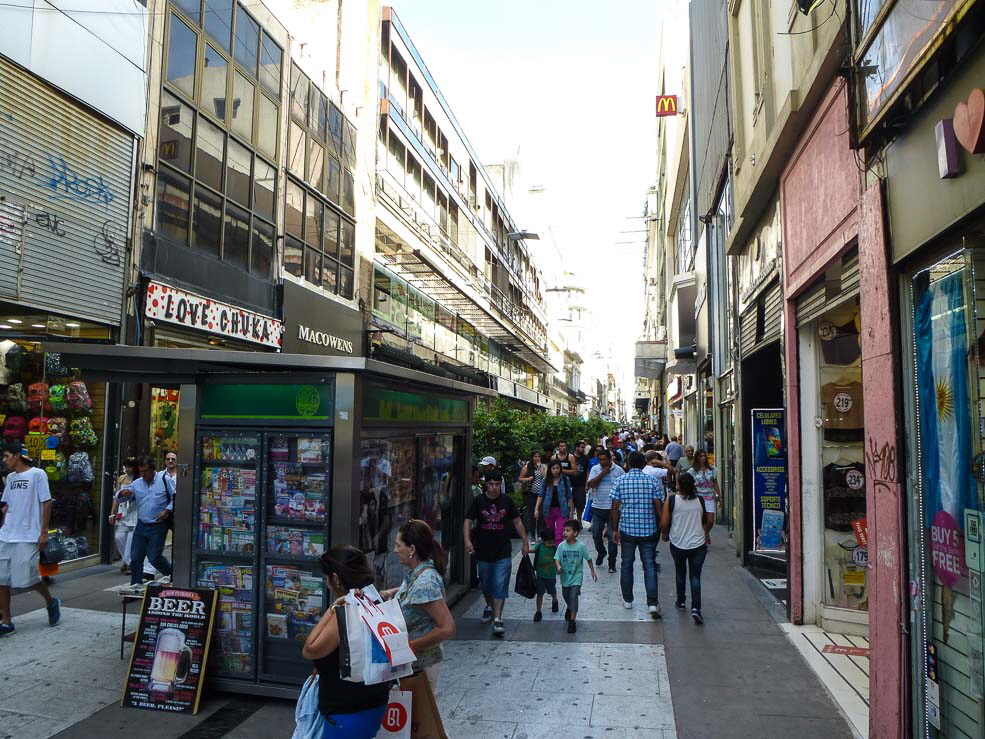
Skeptical in the beginning, we now decided to change some money and spoke to a „book dealer“. Sourrounded by masses of pedestrians this venture seemed safe enough and less adventurous. The dealer asked us to wait a few minutes. After one customer left the kiosk through the tiny door, I was asked in – to our surprise directly under the eyes of two policemen who were leaning against a wall just a few feet away.
The tiny room, which wasn’t even a meter (3 ft) wide, resembled a cashier’s desk. Various little compartments were filled with Euro and Dollar bills. The dealer pointed to a pocket calculator displaying the sum in Pesos which I was to get for my Dollars. He counted the bills in front of me and even offered that I check them under an ultraviolet lamp to ensure their authenticity. For an actually “illegal” transaction everything went very organized, “official” and swift.
Galeria Pacifico, a shopping mall, marked the corner of the street to our hotel.
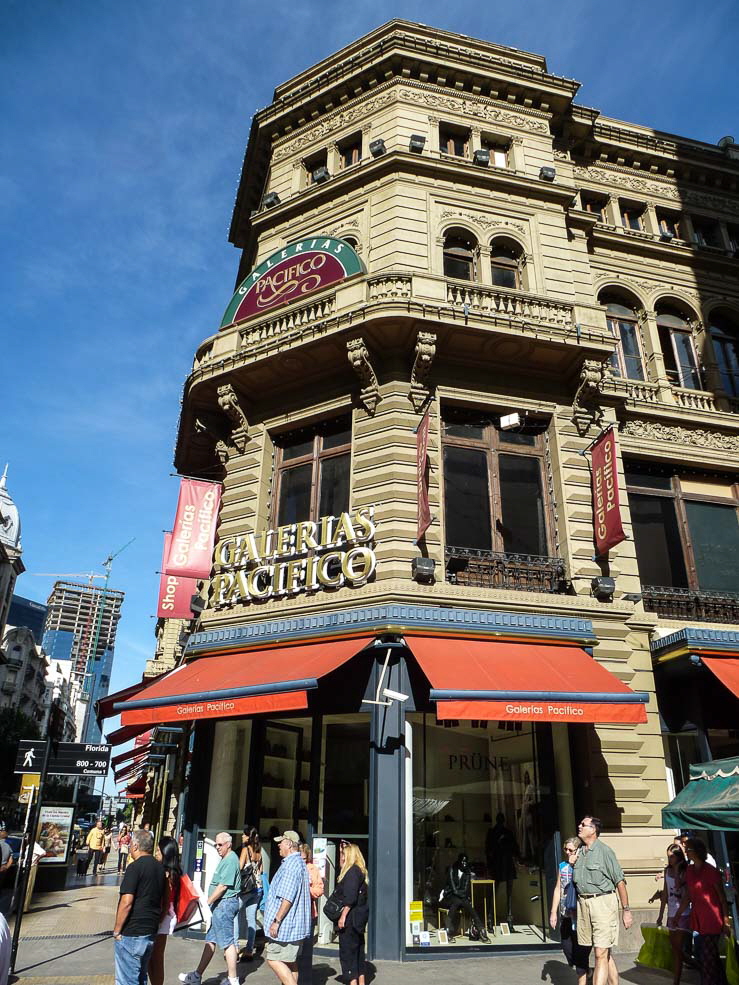
The mall was built based on the foundations of various historical buildings and covered by a curved glass ceiling. The ceiling of a central vault is decorated with artistic fescos. All this probably justifies the term shopping temple...
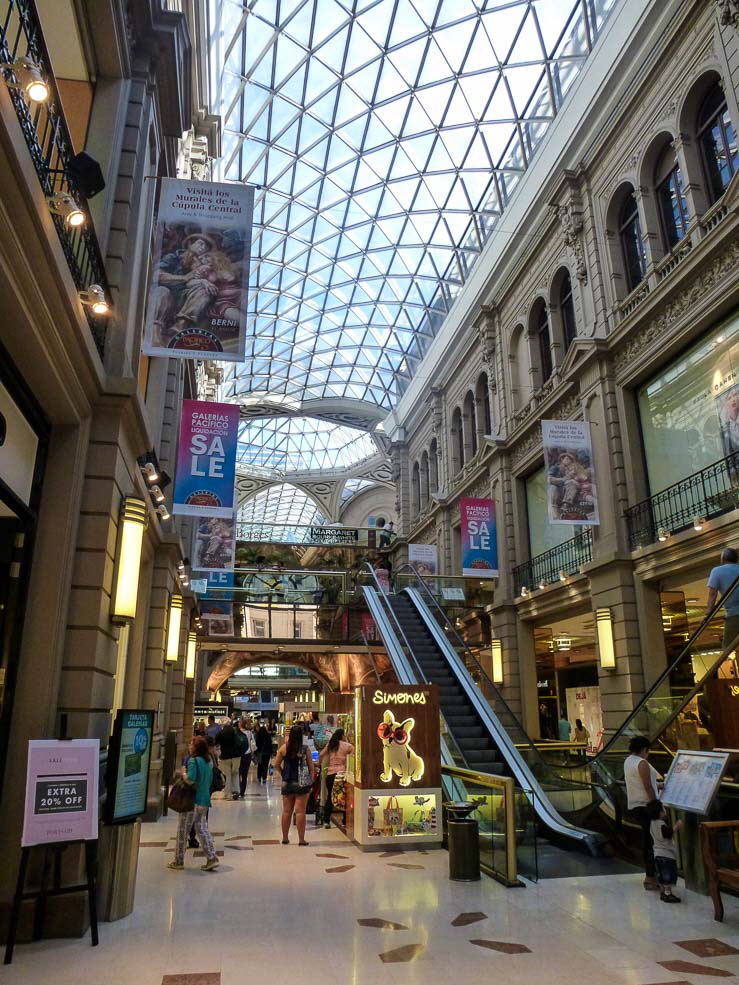
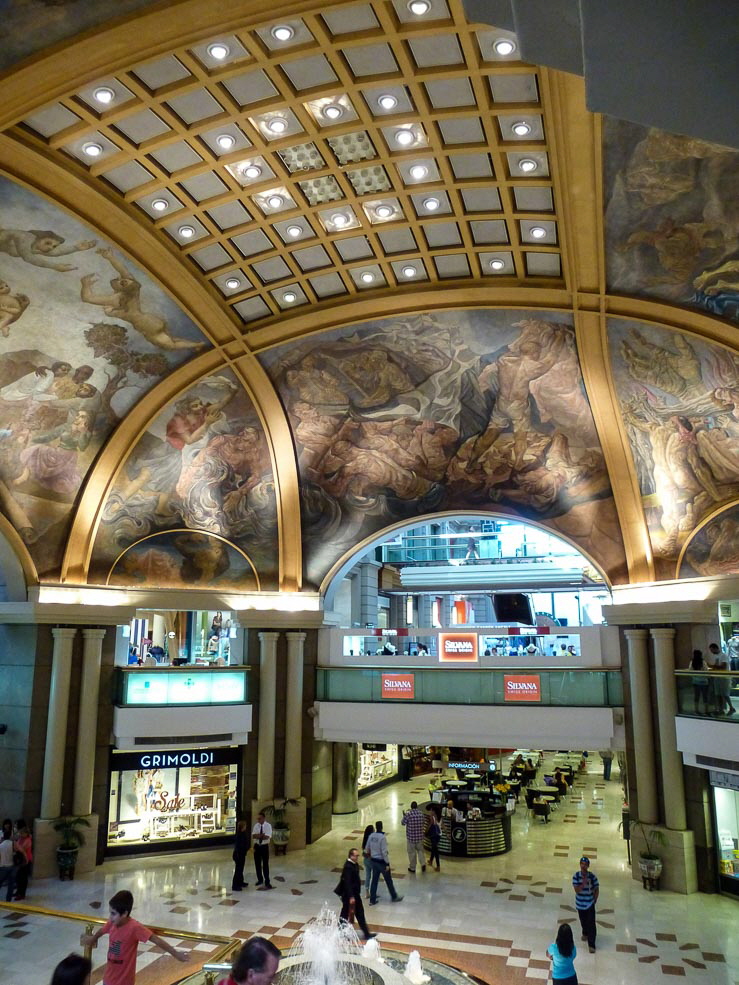
For the total of 8 km (5 miles) we had walked that day, we thought we should reward ourselves with a nice Argentinian steak. The hotel recommended “La Chacra”, which was only a few minutes walk away. We followed the advice, enjoyed the rustic atmosphere of the place and the first decent piece of beef on the South American continent - and were happy about this successful start of our trip.
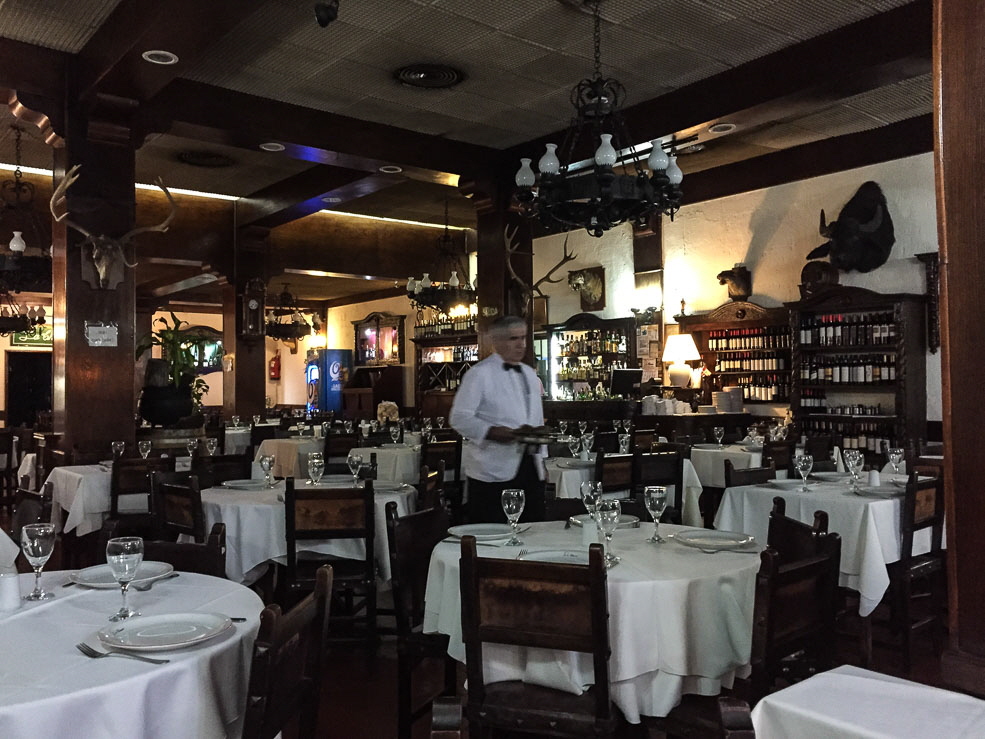
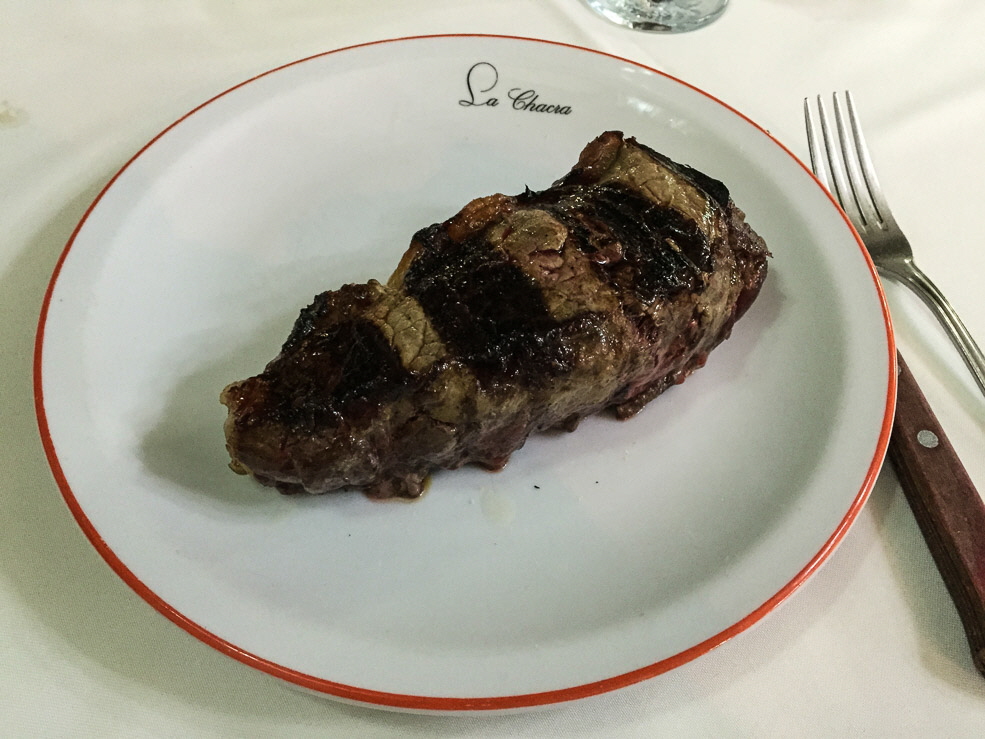
www.travellove.one • www.thecruise.report • www.travelandcruise.net
© 2021 Die Rechte an Texten, Fotos und Videos liegen beim Autor der Webseite. Die Nutzung ist nur nach ausdrücklicher Freigabe erlaubt.
